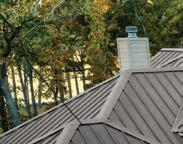



















GLAMPING
IN STYLE



PICTURE THIS: FRONT

PORCHES

MAGICAL FAIRY GARDENS
























GLAMPING



PICTURE THIS: FRONT






Eight Mississippi electric cooperatives spent Sept. 17 out at community colleges helping students register to vote.
Sept. 17 was National Voter Registration Day.
The cooperatives that participated were 4-County Electric, Coahoma Electric, Coast Electric, Northcentral Electric Cooperative, Singing River Electric, Southern Pine Electric, Southwest Electric, and Tallahatchie Valley Electric Power.
The Mississippi events this year are part of a nationwide e ort led by Co-ops Vote. The annual civic engagement holiday had over 3,000 community partners hosting events last year.
Voter registration drives were held on multiple campuses throughout the day.






Pearl River Valley Electric Power Association, in partnership with Cooperative Energy, announce recently that the Marion County Development Partnership (MCDP) has been awarded a Cooperative Competes grant of $12,500. This funding will support a Comprehensive Workforce Study conducted by VisionFirst, an economic development consulting firm, as a crucial step in establishing a master plan for the Marion Regional AirPlex and IndustryPlex.
In addition to the Cooperative Competes grant, MCDP has secured $420,000 in additional funding through the Mississippi Development Authority’s Select Site Grant Program and the Cooperative Energy Site Invest Program. The project’s scope includes workforce studies, tra c flow analysis, geotechnical evaluations, and master planning by a specialized engineering and site selection firm.









MCDP has successfully leveraged these resources, along with some matching funds from the Mississippi Power Propel Grant program, to undertake this vital planning process. The goal is to enhance the competitive positioning and refine the marketing strategy for the industrial properties within the Marion County Economic Development District.
The Cooperative Competes initiative is designed to boost community competitiveness and promote economic growth across Mississippi. Through this initiative, economic development organizations can apply for grants to support industrial property development, workforce enhancement, or community growth projects. The funds are provided jointly by Cooperative Energy’s 11 Member distribution cooperatives.










“Improving the quality of life for all those we touch.”
Fall is a busy time, and October is a particularly eventful month with school, community, and sports activities in full swing. It’s also when all cooperatives celebrate National Co-op Month.
When I say 4-County celebrates Co-op Month (see page 17), it really means we are celebrating you! After all, our co-op wouldn’t exist without you, our members.
Our core business purpose is to serve as your electricity provider, but the larger mission of the co-op is to help make our corner of the world a better place. “Concern for community” is one of seven guiding principles that all co-ops share.
Similar to how our wires run through our service territory, our concern for community flows through all of our decisions — because being a co-op means being a responsible partner and good neighbor.
4-County works to help our community thrive through initiatives led by our employees and local board that’s comprised of neighbors who live right here in our community. Because we’re local, we understand our community’s unique needs and strive to help meet them.
We’re proud to support local youth through our Cooperative Youth Leaders Tour and scholarship programs. With your help, we o er the 4-County Foundation to provide assistance to our community’s most vulnerable (see recent grants in sidebar to the right).
The word “cooperative” is close to “cooperation,” meaning people working together towards a common goal — mutually benefitting one another and the larger community. That’s the essence of the cooperative spirit. Our employees and memberelected board members are invested in the community in which live and serve.
Above all, as a co-op we put our members’ priorities first. As your trusted energy partner, we know that saving energy and money is important to you. That’s why we have numerous programs in place to help, including energy saving tips, programs, and free audits.
We want to empower you to manage energy use at home. If you haven’t already, I encourage you take a moment and use our app. Just search My Electric Account or 4-County Electric Power Association from the Apple App Store or Google Play Store. Through the app, you can conveniently monitor and manage your energy use. And we’re of course here to help, so give us a call if you have questions about your energy bills.
4-County is continuously examining ways to operate more e ciently while continuing to provide the highest level of friendly, reliable service you expect and deserve. After all, we’re your local co-op. We were built by the members we serve.

by Brian Clark
CEO/General Manager













Eight area organizations received awards recently from the 4-County Electric Power Association Foundation.
About $47,000 was distributed at the foundation’s September meeting at 4-County’s Corporate Center in Mayhew. Since the foundation’s inception in February 2015, over $2.2 million has been dispersed to organizations in 4-County’s nine-county service area. Those receiving foundation awards in September included:
• American Red Cross ($10,000 to purchase supplies and supporting material for a Home Fire Campaign)
• East Webster Elementary School ($8,000 to extend a carpool awning and build a new sidewalk)
• Friends of the Noxubee County Wildlife Refuge ($8,732 for fish structures and habitat renovations)
• My Book of Lowndes County ($1,215 to be used in purchase of 270 books for West Lowndes Elementary School)
• Noxubee County Diabetes Coalition ($2,051 to assist with computer equipment and other program supplies)
• The Mission ($10,000 to purchase cold storage space structures for donated food items)
• Tombigbee Regional Library System ($500 to update non-fiction section of library)
• Town of Mathiston Fire Department ($6,239 to purchase radios and other digital equipment)
For more information on the 4-County Foundation, call 1-800-431-1544.
4-County Electric Power Association has enacted a slight increase to its electric rates. The move comes on the heels of a significant base rate increase voted on by the Tennessee Valley Authority (TVA) in August.
Rate increases went into e ect Oct. 1. The 4-County increase (about 2.34 %) will mean roughly an extra $3.56 a month to the average residential electric bill. Combined with the TVA wholesale increase of 5.25%, the total e ect will be about $8.22 a month to the average residential member.
TVA enacted its increase to provide the needed resources to meet demand and load growth. 4-County’s slight increase also addresses those needs and the higher cost of doing business.
“We’re seeing a big rise in interest rates, and our costs for doing business are just skyrocketing. Basic things like poles, wire, and transformers are extremely expensive right now. The cost to replace a bucket truck is staggering. And that’s if you can even get them. The wait time for a lot of these things is now months instead of days or weeks,” 4-County CEO Brian Clark noted.
One of the impacts driving these changes for both 4-County and TVA is growth. “We’re seeing exceptional growth in our
service territory. We’re adding load every year, especially with larger commercial members. That’s great, but it also means we’ve got to make additions to our system. TVA is seeing the same thing with unexpected growth across the Tennessee Valley. They’ve got to quickly add generation to meet all our needs. So, it is a doubleedged sword. People want to live here; companies want to locate here, but we’ve got to be able to serve all of them,” said Clark. “Our goal is to again go as long as we can without having another rate adjustment.”
Through a combination of e orts, 4-County has been able to avoid significantly raising its rates for several years. The co-op was even able to absorb a 2016 rate increase from TVA and not pass it on to its members. “That move alone saved 4-County members more than $10 million dollars,” Clark said. Clark pointed to other money saving measures the cooperative has undertaken including reducing employee headcount through attrition, using technology to provide more e cient and less costly service, and developing and implementing many financially prudent internal processes and decisions.
For more information, call 4-County at 1-800-431-1544.
Now is the time to schedule annual maintenance for your home’s heating system. During the fall months, HVAC technicians are typically less busy, making this an excellent time for maintenance and any necessary repairs before the winter months.
A qualified technician can clean filters, check for leaks and ensure all system components are working e ciently to keep your home cozy and warm when the temperatures begin to drop.





























Cora served in a variety of Member Service roles in her career. Enjoy Your Retirement!





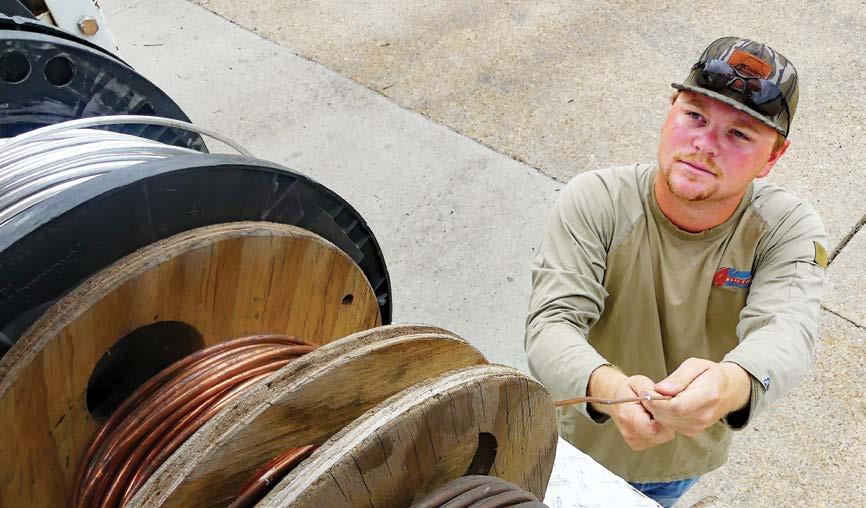





Rivers flow at their own pace, teaching us patience and the art of going with the current. Life for each of us has its own unique twists and turns, but 4-County Apprentice 1 Shaw Adcock is always excited to see what’s just around the bend. “There’s always a sense of anticipation on the river, wondering what’s next,” Adcock explained. Riding innertubes and relaxing on the sandbar are part of it. “We just enjoy being outside, seeing nature at work.”
Life for Adcock took an interesting turn itself several years ago while he was working with a rights-of-way contracting crew. “I started really noticing the power poles and lines. I wanted to understand how the power lines connected and worked together. It interested me,” he said. That interest led to attending and graduating from East Mississippi Community College’s (EMCC) Lineman Training School. He credited his instructor, retired 4-County Journeyman Lineman Chuck Cotton, and current co-op Journeyman Lineman Derek Dawkins as providing needed encouragement.


The job at 4-County, he described, is hard work but very rewarding. “Sometimes, it’s hard days and long nights. But it makes a big di erence when you know you are keeping the lights on for people.”
We’re looked upon by the community with respect.
Adcock describes his father, Champ, as a wonderful role model. “We see each other every weekend. He’s been a spiritual influence and a leader in my growth and development as a person,” he added. The father-son duo has been joined by other family members and friends in Shaw’s conversion of a camp house into a home. “I’m learning a lot,” he said. “It’s nice to watch as it goes from the before to the after.”
— Shaw Adcock —
As a 4-County employee, Adcock explained, it’s also good to see a construction project develop from start to finish. Communities admire the coop. “It’s a big accomplishment when finishing a project. When it’s completed, it’s cool to know you had a hand in it.”
Adcock’s career at 4-County began in 2022. The Nanih Waiya High School graduate lives in Macon, where he attends Calvary Baptist Church. When he’s not working, Shaw enjoys being with family, playing golf, riding four-wheelers, hunting, and fishing.

Doing the job the right way is the only way, Adcock said. “We’re looked upon by the community with respect,” he added. “That’s important. We treat them well, and they treat us well. Members and employees are all part of one big, happy co-op family.”








































A tradition of dependable, hometown service since 1937


CARTHAGE: 601-267-5671 | PHILADELPHIA: 601-656-2601 | RANKIN: 601-829-1201 | SEBASTOPOL: 601-625-7422







by Abby Berry


Communities come in all shapes and sizes. Some are based on geographical proximity; some are based on shared interests or hobbies, and some communities can even be found in virtual spaces like social media groups. Regardless of where or how they are formed, communities can bring people together and create a sense of belonging.
Central Electric is deeply committed to our consumermembers, and we’re glad you are part of the electric cooperative community.
This month, more than 30,000 cooperatives across the U.S. are celebrating National Co-op Month. It’s a time to reflect on all the aspects that set cooperatives apart from other types of businesses, but more importantly, it’s a time to celebrate the power of co-op membership.
Electric cooperatives are not-for-profit utilities that are built by the communities they serve. For Central Electric, our mission has always been to provide you with reliable power. We care about your quality of life, and because we are locally operated, we’re uniquely suited to meet our members’ evolving energy needs.
Beyond the business of electricity, our employees and directors are equally invested in our local community. Why? Because we live here, too. That’s why we work hard to support local economic development projects, youth programs and scholarships, charitable giving initiatives and additional programs that make our community a better place to call home.
All co-ops, including Central Electric, are guided by seven cooperative principles that embody the values and spirit of the cooperative movement.
These seven principles are a framework to help all co-ops navigate challenges and opportunities while remaining true to our purpose:
1. Open and Voluntary Membership: Co-op membership is open to anyone who can use the co-op’s services.
2. Democratic Member Control: Members make decisions that shape the cooperative. Why? Because co-ops are created by the members, for the members.
3. Members’ Economic Participation: Members contribute money to the co-op to make sure it runs smoothly now and in the future. At Central Electric, this happens through paying your energy bills.
4. Autonomy and Independence: Co-ops are independent and can operate on their own, which ultimately benefits the members.
5. Education, Training, and Information: Co-ops continuously focus on education to ensure employees have the training and information they need to make the co-op successful.
6. Cooperation Among Cooperatives: Co-ops share with and learn from other cooperatives. We help each other out in times of need because we want other co-ops to thrive.
7. Concern for Community: All cooperatives work for the greater good of the local communities they serve. Co-ops give back to their communities to help them thrive and grow.
This October, as we celebrate National Co-op Month and the power of membership, we hope you will recognize the many aspects that set electric cooperatives apart. Our mission is reliable power. Our purpose is people — the local communities we’re proud to serve.


















QDo you have any tips on finding hidden energy savings in my home?
by Miranda Boutelle
Using your attic for storage can be problematic when trying to maximize your home’s energy e ciency. Let’s explore how you can improve insulation levels and properly store items in your attic.
Attic insulation is one of the best low-cost ways to make your home e cient. People often associate insulation with keeping your home warmer in the winter, but it also provides benefits in the summer. Insulation reduces heat transfer from the attic to the house, which lowers energy bills for air conditioning and makes your home more comfortable.
AI’ve been in a lot of homes. One common hiding spot for energy savings is the attic. It is also a common location for storing holiday decorations and infrequently used sentimental items.
Attic insulation is measured in R-value, which is a measurement of how well a material resists the flow of heat. For attic insulation, thicker is better. The recommended R-value is typically between R-38 and R-60, depending on your climate. Hawaii and the southernmost tips of Florida and Texas recommend R-30. Measured in inches, that ranges from around 10 to 20 inches, depending on the type of insulation you have. In most homes, the ceiling joists are buried in insulation to achieve the recommended R-value.
The problem with attic storage is it typically doesn’t o er enough space for the recommended R-value. Often, plywood or boards are placed directly on top of the ceiling joists, which isn’t enough space for the insulation. Insulation can get compacted by people moving items in or out, reducing the e ective R-value.
Ideally, the attic would not be used for storage so it can be properly insulated, but that’s not feasible for everyone. Here are some strategies for maintaining attic storage and recommended insulation levels.
The best location for attic storage is over an unconditioned area of your home, such as the garage. You don’t need insulation in attic spaces over a garage or unconditioned area because you are not heating or cooling the space below. This makes it the perfect spot to tuck away items for storage.
If that isn’t an option, consider minimizing the number of stored items or the storage area’s footprint. A great way to do this is by building an attic storage platform. A raised platform allows the space underneath it to be fully insulated. These platforms are available in ready-to-install kits, or you can buy materials and build them yourself.

Your attic might also have trusses that allow you to build shelves and maximize space by storing items vertically.
Allow enough space underneath the platform to achieve the proper R-value. Use lumber to build a frame perpendicular to the existing joists and cover it with plywood or oriented strand board. Once your storage area is set up, add insulation inside the platform to bring the R-value up to the proper level.
Your attic might also have trusses that allow you to build shelves and maximize space by storing items vertically.
Always wear a dust mask or respirator when working in the attic. Don’t forget to weatherstrip the attic hatch to ensure a tight seal. Take a look around your attic to see if you can find any hidden opportunities for energy savings.
Miranda Boutelle is the chief operating o cer at E ciency Services Group in Oregon, a cooperatively owned energy e ciency company.



















E ective Oct. 1, 2024, Tennessee Valley Authority (TVA) will adjust their wholesale power rates by 5.25% to Central Electric Power Association to provide the needed resources to support demand and load growth. In conjunction with the TVA adjustment, Central Electric Power Association is adjusting its retail electric rates by 0.9%. With TVA and Central EPA adjustments, our average residential


consumer with an energy usage of 1250 kilowatt hours will experience a $6.57 increase in their electric bill.
It is our goal at Central Electric to provide our consumers with reliable and a ordable electric service. The Association takes this responsibility very seriously and strives to hold down costs in all areas of our operation.

























by Qua’shara Monix
Halloween is a fun and exciting, but safety is crucial to ensure that everyone, especially children, has an enjoyable experience. With the combination of costumes, trick-or-treating, and nighttime activities, there are several potential hazards. Prioritizing Halloween safety helps prevent accidents and ensures that the evening is filled with positive memories. Being safe around electrical lines during Halloween is essential, especially with outdoor decorations, costumes, and trick-or-treating activities. Here’s how to ensure safety around electrical lines.
1.
• Keep a safe distance - When setting up decorations, make sure to keep them at least 10 feet away from power lines and utility poles. Avoid hanging anything from power lines, as this could cause electrical hazards.
• Use grounded outdoor outlets - Only plug decorations into grounded, outdoor-rated electrical outlets. This reduces the risk of electrical shock and fire.
• Avoid overloading circuits - Don’t overload extension cords or outlets with too many decorations. Overloaded circuits can cause electrical fires.
• Inspect wires and cords - Before using them, inspect extension cords and decoration wiring for damage or fraying. Replace any damaged cords immediately.
2. COSTUMES
• Avoid metallic costumes - Steer clear of costumes with metallic materials, especially near power lines. Metal can conduct electricity, increasing the risk of shock.
• Be mindful of tall costumes - Costumes that are tall or have props (think broomsticks or fake swords) can accidentally hit overhead power lines. Make sure that costumes or props aren’t too tall to avoid this danger.
3. TRICK-OR-TREATING
• Stay away from power lines and substations - Instruct children to stay clear of power lines, electrical substations, and transformers. Never attempt to retrieve anything that gets caught in a power line — call the utility company instead.
• Walk safely - Stick to sidewalks and avoid walking under lowhanging power lines. If a power line is down, stay far away from it and report it to the authorities immediately.
• Be cautious in stormy weather - If the weather is stormy or windy, be extra cautious. High winds can bring down power lines, creating dangerous conditions.
• Use battery-operated decorations - Consider using batteryoperated decorations instead of plug-in ones, especially in areas where power lines are close by.
• Educate children - Teach children about the dangers of electrical lines and what to do if they encounter a hazardous situation.
• Report hazards - If you notice any downed power lines or damaged electrical equipment, report it to the utility company or local authorities immediately.
By following these guidelines, you can help ensure that Halloween remains safe and enjoyable while avoiding potential electrical hazards.





















QDo you have any tips on finding hidden energy savings in my home?
by Miranda Boutelle
Using your attic for storage can be problematic when trying to maximize your home’s energy e ciency. Let’s explore how you can improve insulation levels and properly store items in your attic.
Attic insulation is one of the best low-cost ways to make your home e cient. People often associate insulation with keeping your home warmer in the winter, but it also provides benefits in the summer. Insulation reduces heat transfer from the attic to the house, which lowers energy bills for air conditioning and makes your home more comfortable.
AI’ve been in a lot of homes. One common hiding spot for energy savings is the attic. It is also a common location for storing holiday decorations and infrequently used sentimental items.
Attic insulation is measured in R-value, which is a measurement of how well a material resists the flow of heat. For attic insulation, thicker is better. The recommended R-value is typically between R-38 and R-60, depending on your climate. Hawaii and the southernmost tips of Florida and Texas recommend R-30. Measured in inches, that ranges from around 10 to 20 inches, depending on the type of insulation you have. In most homes, the ceiling joists are buried in insulation to achieve the recommended R-value.
The problem with attic storage is it typically doesn’t o er enough space for the recommended R-value. Often, plywood or boards are placed directly on top of the ceiling joists, which isn’t enough space for the insulation. Insulation can get compacted by people moving items in or out, reducing the e ective R-value.
Ideally, the attic would not be used for storage so it can be properly insulated, but that’s not feasible for everyone. Here are some strategies for maintaining attic storage and recommended insulation levels.
The best location for attic storage is over an unconditioned area of your home, such as the garage. You don’t need insulation in attic spaces over a garage or unconditioned area because you are not heating or cooling the space below. This makes it the perfect spot to tuck away items for storage.
If that isn’t an option, consider minimizing the number of stored items or the storage area’s footprint. A great way to do this is by building an attic storage platform. A raised platform allows the space underneath it to be fully insulated. These platforms are available in ready-to-install kits, or you can buy materials and build them yourself.

Your attic might also have trusses that allow you to build shelves and maximize space by storing items vertically.
Allow enough space underneath the platform to achieve the proper R-value. Use lumber to build a frame perpendicular to the existing joists and cover it with plywood or oriented strand board. Once your storage area is set up, add insulation inside the platform to bring the R-value up to the proper level.
Your attic might also have trusses that allow you to build shelves and maximize space by storing items vertically.
Always wear a dust mask or respirator when working in the attic. Don’t forget to weatherstrip the attic hatch to ensure a tight seal. Take a look around your attic to see if you can find any hidden opportunities for energy savings.
Miranda Boutelle is the chief operating o cer at E ciency Services Group in Oregon, a cooperatively owned energy e ciency company.





















by Abby Berry
Did you know the average household with internet access owns about 17 connected devices? That figure covers a wide range of electronics, including smart phones, computers, streaming devices, smart speakers, home assistants, and more. Given our increasing reliance on internet-connected technologies, the likelihood of new cyber threats is ever-present.
Coahoma Electric is deeply committed to ensuring our local system is safe and secure. We routinely monitor and manage cyber risks, and we work together with other co-ops to share the latest advancements in cybersecurity measures that make us stronger. But you can help, too.






When we all work together to stay safe online, we lower the risk of cyber threats to our systems, online accounts, and sensitive data.
October is National Cybersecurity Month, and while good cyber hygiene should be practiced year-round, we’d like to share a few cybersecurity tips to help you bolster your online safety.
Let’s all do our part to stay cyber smart and create a safer digital world for all. Visit staysafeonline.org to learn about additional cybersecurity tips.
Abby Berry writes on consumer and cooperative a airs for the National Rural Electric Cooperative Association.

Learn how to spot and report phishing attempts. Phishing occurs when criminals use phony emails, direct messages or other types of digital communications that lure you to click a bad link or download a malicious attachment. If you receive a suspicious email or message that includes urgent language, o ers that seem too good to be true, generic greetings, poor grammar, or an unusual sender address, it could be a phishing attempt. If you spot one, report it as soon as possible — and don’t forget to block the sender. (If you receive a suspicious work email, report it to the appropriate IT contact. Suspicious messages that are delivered to your personal email or social media accounts can also be reported.)
Create strong, unique passwords. When it comes to passwords, remember that length trumps complexity. Strong passwords contain at least 12 characters and include a mix of letters, numbers, and symbols. Create unique passwords for each online account you manage and use phrases you can easily remember.
Enable multi-factor authentication when available. Multi-factor authentication (also known as 2-factor authentication) adds an extra layer of security to your online accounts. These extra security steps can include facial recognition, fingerprint access, or one-time codes sent to your email or phone.
Update software regularly. Software and internet-connected devices, including personal computers, smartphones, and tablets, should always be current on updates to reduce the risk of infection from ransomware and malware. When possible, configure devices to automatically update or notify you when an update is available.






























Communities come in all shapes and sizes. Some are based on geographical proximity, some are based on shared interests or hobbies, and some communities can even be found in virtual spaces like social media groups. Regardless of where or how they are formed, communities can bring people together and create a sense of belonging.
Coast Electric is deeply committed to our consumer-members, and we’re glad you are part of the electric cooperative community.
This month, more than 30,000 cooperatives across the U.S. are celebrating National Co-op Month. It’s a time to reflect on all the aspects that set cooperatives apart from other types of businesses, but more importantly, it’s a time to celebrate the power of co-op membership.
Electric cooperatives are not-for-profit utilities that are built by the communities they serve. For Coast Electric, our mission has always been to provide you with reliable power. We care about your quality of life, and because we are locally operated, we’re uniquely suited to meet our members’ evolving energy needs.
Beyond the business of electricity, our employees and directors are equally invested in our local community. Why? Because we live here, too. That’s why we work hard to support local economic development projects, youth programs and scholarships, charitable giving initiatives and additional programs that make our community a better place to call home.
All co-ops, including Coast Electric, are guided by seven cooperative principles that embody the values and spirit of the cooperative movement.

by Ron Barnes
President and CEO




These seven principles are a framework to help all co-ops navigate challenges and opportunities while remaining true to our purpose:
1. Open and Voluntary Membership: Co-op membership is open to anyone who can use the co-op’s services.
2. Democratic Member Control: Members make decisions that shape the cooperative. Why? Because co-ops are created by the members, for the members.
3. Members’ Economic Participation: Members contribute money to the co-op to make sure it runs smoothly now and in the future. At Coast Electric, this happens through paying your energy bills.
4. Autonomy and Independence: Co-ops are independent and can operate on their own, which ultimately benefits the members.
5. Education, Training, and Information: Co-ops continuously focus on education to ensure employees have the training and information they need to make the co-op successful.
6. Cooperation Among Cooperatives: Co-ops share with and learn from other cooperatives. We help each other out in times of need because we want other co-ops to thrive.
7. Concern for Community: All cooperatives work for the greater good of the local communities they serve. Co-ops give back to their communities to help them thrive and grow.
This October, as we celebrate National Co-op Month and the power of membership, we hope you will recognize the many aspects that set electric cooperatives apart. Our mission is reliable power. Our purpose is people — the local communities we’re proud to serve.


Whether you are trying to pay a bill, report an outage or check your account balance, texting Coast Electric is one of the quickest, easiest ways to stay connected. While texting has been an option for our members for a while, we have a new number and updated features that o er members a better user experience. With our new system, you no longer need to enter specific menu items. Our new system is able to understand your request.
• You must first have a mobile number associated with your account before you can utilize texting services. If you do not have a mobile number tied to your account, you can call us at 877-769-2372 or log on to www.coastelectric.coop and click “My Account” to log in and update your contact information.
• Once your mobile number is tied to your account, all you have to do is text us at our new number 228-338-4644.








• Check your account balance
• Make a payment


• Report an outage
• Speak to a member service representative





• Visit www.coastelectric.coop/annual-meeting-registration
• Review candidate bios and meeting information
• Click “Register your proxy”
• Enter your member number (numbers before the dash only)
• Enter your five-digit billing zip code
• Click “Go”
• Follow the instructions

Nov. 1 will mark our Time of Use (TOU) rate time change. For those of you who are taking advantage of our TOU rate, please note that our peak times will change from our summer hours (3-6 p.m. Monday-Friday) to winter hours (6-8 a.m. Monday-Friday). That means that only 10 hours of 168 hours in the week are peak hours.
During the holidays, TOU is the gift that keeps giving. Thanksgiving Day, Christmas Day and New Year’s Day are o -peak prices all day long!
If you aren’t trying our TOU rate, now is the time! This rate allows you to save if you avoid energy use during peak hours. You have the control to save on your monthly energy costs. Just imagine what those savings can do for you this holiday season! If you are hesitant, don’t worry. With our six-month guarantee, you can see what your bill would have been on our traditional rate. If you would have saved more on that rate or if you decide TOU isn’t for you for any reason, you can switch back, and we will refund the savings you would have seen to your account.
Coast Electric wants you to reduce your energy use and see savings on your energy costs. Each month, you will have an opportunity to register to win a prize that will help you reduce the energy consumption in your home. All you have to do is visit www.coastelectric.coop and fill out our entry form. It only takes a few seconds, and you could win a prize that helps you save!
Congratulations to Donna McCoy, the winner of our August Reduce Your Use prize!




































by Abby Berry










Did you know the average household with internet access owns about 17 connected devices? That figure covers a wide range of electronics, including smartphones, computers, streaming devices, smart speakers, home assistants, and more. Given our increasing reliance on internet-connected technologies, the likelihood of new cyber threats is ever-present.
CoastConnect is deeply committed to ensuring our local system is safe and secure. We routinely monitor and manage cyber risks, and we work together with other co-ops to share the latest advancements in cybersecurity measures that make us stronger. But you can help, too.










When we all work together to stay safe online, we lower the risk of cyber threats to our systems, online accounts, and sensitive data.
October is National Cybersecurity Month, and while good cyber hygiene should be practiced year-round, we’d like to share a few cybersecurity tips to help you bolster your online safety.
Let’s all do our part to stay cyber-smart and create a safer digital world for all. Visit staysafeonline.org to learn about additional cybersecurity tips.
Abby Berry writes on consumer and cooperative a airs for the National Rural Electric Cooperative Association.






Learn how to spot and report phishing attempts. Phishing occurs when criminals use phony emails, direct messages or other types of digital communications that lure you to click a bad link or download a malicious attachment. If you receive a suspicious email or message that includes urgent language, o ers that seem too good to be true, generic greetings, poor grammar or an unusual sender address, it could be a phishing attempt. If you spot one, report it as soon as possible — and don’t forget to block the sender. If you receive a suspicious work email, report it to the appropriate IT contact. Suspicious messages that are delivered to your personal email or social media accounts can also be reported.
Create strong, unique passwords. When it comes to passwords, remember that length trumps complexity. Strong passwords contain at least 12 characters and include a mix of letters, numbers and symbols. Create unique passwords for each online account you manage and use phrases you can easily remember.







Enable multi-factor authentication when available. Multi-factor authentication (also known as 2-factor authentication) adds an extra layer of security to your online accounts. These extra security steps can include facial recognition, fingerprint access, or one-time codes sent to your email or phone.
Update software regularly. Software and internet-connected devices, including personal computers, smartphones and tablets, should always be current on updates to reduce the risk of infection from ransomware and malware. When possible, configure devices to automatically update or notify you when an update is available.



























by Abby Berry

Communities come in all shapes and sizes. Some are based on geographical proximity; some are based on shared interests or hobbies, and some communities can even be found in virtual spaces like social media groups. Regardless of where or how they are formed, communities can bring people together and create a sense of belonging.
Delta Electric is deeply committed to our consumer-members, and we’re glad you are part of the electric cooperative community.
This month, more than 30,000 cooperatives across the U.S. are celebrating National Co-op Month. It’s a time to reflect on all the aspects that set cooperatives apart from other types of businesses, but more importantly, it’s a time to celebrate the power of co-op membership.
Electric cooperatives are not-for-profit utilities that are built by the communities they serve. For Delta Electric, our mission has always been to provide you with reliable power. We care about your quality of life, and because we are locally operated, we’re uniquely suited to meet our members’ evolving energy needs.
Beyond the business of electricity, our employees and directors are equally invested in our local community. Why? Because we live here, too. That’s why we work hard to support local economic development projects, youth programs and scholarships, charitable giving initiatives and additional programs that make our community a better place to call home.
All co-ops, including Delta Electric, are guided by seven cooperative principles that embody the values and spirit of the cooperative movement.
These seven principles are a framework to help all co-ops navigate challenges and opportunities while remaining true to our purpose:
1. Open and Voluntary Membership: Co-op membership is open to anyone who can use the co-op’s services.
2. Democratic Member Control: Members make decisions that shape the cooperative. Why? Because co-ops are created by the members, for the members.
3. Members’ Economic Participation: Members contribute money to the co-op to make sure it runs smoothly now and in the future. At Delta Electric, this happens through paying your energy bills.
4. Autonomy and Independence: Co-ops are independent and can operate on their own, which ultimately benefits the members.
5. Education, Training, and Information: Co-ops continuously focus on education to ensure employees have the training and information they need to make the co-op successful.
6. Cooperation Among Cooperatives: Co-ops share with and learn from other cooperatives. We help each other out in times of need because we want other co-ops to thrive.
7. Concern for Community: All cooperatives work for the greater good of the local communities they serve. Co-ops give back to their communities to help them thrive and grow.
This October, as we celebrate National Co-op Month and the power of membership, we hope you will recognize the many aspects that set electric cooperatives apart. Our mission is reliable power. Our purpose is people — the local communities we’re proud to serve.
cooperative a airs for the National Rural


























QDo you have any tips on finding hidden energy savings in my home?
by Miranda Boutelle
Using your attic for storage can be problematic when trying to maximize your home’s energy e ciency. Let’s explore how you can improve insulation levels and properly store items in your attic.
Attic insulation is one of the best low-cost ways to make your home e cient. People often associate insulation with keeping your home warmer in the winter, but it also provides benefits in the summer. Insulation reduces heat transfer from the attic to the house, which lowers energy bills for air conditioning and makes your home more comfortable.
AI’ve been in a lot of homes. One common hiding spot for energy savings is the attic. It is also a common location for storing holiday decorations and infrequently used sentimental items.
Attic insulation is measured in R-value, which is a measurement of how well a material resists the flow of heat. For attic insulation, thicker is better. The recommended R-value is typically between R-38 and R-60, depending on your climate. Hawaii and the southernmost tips of Florida and Texas recommend R-30. Measured in inches, that ranges from around 10 to 20 inches, depending on the type of insulation you have. In most homes, the ceiling joists are buried in insulation to achieve the recommended R-value.
The problem with attic storage is it typically doesn’t o er enough space for the recommended R-value. Often, plywood or boards are placed directly on top of the ceiling joists, which isn’t enough space for the insulation. Insulation can get compacted by people moving items in or out, reducing the e ective R-value.
Ideally, the attic would not be used for storage so it can be properly insulated, but that’s not feasible for everyone. Here are some strategies for maintaining attic storage and recommended insulation levels.
The best location for attic storage is over an unconditioned area of your home, such as the garage. You don’t need insulation in attic spaces over a garage or unconditioned area because you are not heating or cooling the space below. This makes it the perfect spot to tuck away items for storage.
If that isn’t an option, consider minimizing the number of stored items or the storage area’s footprint. A great way to do this is by building an attic storage platform. A raised platform allows the space underneath it to be fully insulated. These platforms are available in ready-to-install kits, or you can buy materials and build them yourself.

Your attic might also have trusses that allow you to build shelves and maximize space by storing items vertically.
Allow enough space underneath the platform to achieve the proper R-value. Use lumber to build a frame perpendicular to the existing joists and cover it with plywood or oriented strand board. Once your storage area is set up, add insulation inside the platform to bring the R-value up to the proper level.
Your attic might also have trusses that allow you to build shelves and maximize space by storing items vertically.
Always wear a dust mask or respirator when working in the attic. Don’t forget to weatherstrip the attic hatch to ensure a tight seal. Take a look around your attic to see if you can find any hidden opportunities for energy savings.
Miranda Boutelle is the chief operating o cer at E ciency Services Group in Oregon, a cooperatively owned energy e ciency company.





















by Abby Berry
Did you know the average household with internet access owns about 17 connected devices? That figure covers a wide range of electronics, including smart phones, computers, streaming devices, smart speakers, home assistants, and more. Given our increasing reliance on internet-connected technologies, the likelihood of new cyber threats is ever-present.
Delta Electric is deeply committed to ensuring our local system is safe and secure. We routinely monitor and manage cyber risks, and we work together with other co-ops to share the latest advancements in cybersecurity measures that make us stronger. But you can help, too.






When we all work together to stay safe online, we lower the risk of cyber threats to our systems, online accounts, and sensitive data.
October is National Cybersecurity Month, and while good cyber hygiene should be practiced year-round, we’d like to share a few cybersecurity tips to help you bolster your online safety.
Let’s all do our part to stay cyber smart and create a safer digital world for all. Visit staysafeonline.org to learn about additional cybersecurity tips.
Abby Berry writes on consumer and cooperative a airs for the National Rural Electric Cooperative Association.

Learn how to spot and report phishing attempts. Phishing occurs when criminals use phony emails, direct messages or other types of digital communications that lure you to click a bad link or download a malicious attachment. If you receive a suspicious email or message that includes urgent language, o ers that seem too good to be true, generic greetings, poor grammar, or an unusual sender address, it could be a phishing attempt. If you spot one, report it as soon as possible — and don’t forget to block the sender. (If you receive a suspicious work email, report it to the appropriate IT contact. Suspicious messages that are delivered to your personal email or social media accounts can also be reported.)
Create strong, unique passwords. When it comes to passwords, remember that length trumps complexity. Strong passwords contain at least 12 characters and include a mix of letters, numbers, and symbols. Create unique passwords for each online account you manage and use phrases you can easily remember.
Enable multi-factor authentication when available. Multi-factor authentication (also known as 2-factor authentication) adds an extra layer of security to your online accounts. These extra security steps can include facial recognition, fingerprint access, or one-time codes sent to your email or phone.
Update software regularly. Software and internet-connected devices, including personal computers, smartphones, and tablets, should always be current on updates to reduce the risk of infection from ransomware and malware. When possible, configure devices to automatically update or notify you when an update is available.




























October is Cooperative Month, a time when we celebrate the unique principles that guide Dixie Electric and set us apart from other utilities. One principle that stands out for Dixie Electric in October is member democratic control, which empowers you, our members, to have a direct say in the governance of our cooperative through voting in annual board elections. Our annual meeting is held each year, typically on the third Saturday in October, at which we announce the results of our annual board elections. I wanted to take this opportunity to explain a few important details about how you can participate and make your vote count.
Our annual board elections began in late August and closes this year on October 14. Voting allows you to choose the leaders who will guide Dixie Electric and make decisions that impact all members. Board members serve a three-year term and represent the interests of the entire cooperative, not just a specific district. Because of that, our members are able to vote for every district that is up for election, not just the one where they reside. Advertisements from May through July in Today in Mississippi inform members about which districts are up for election and how to pick up a board packet if they wish to run. We do this to be transparent and encourage active participation from our members.
We o er members several ways to vote, and the way you choose to vote is up to you; we just encourage you to participate. You can vote by ballot or proxy in one of three ways: online, through the mail, or at the annual meeting. Additionally, members can vote by proxy at any of our three o ce locations. Here’s the di erence between a ballot and a proxy:
Ballot: A direct vote cast by a member.
Proxy: When a member designates someone else to cast their vote on their behalf. This can be another member or the board of directors.
If you submit both a ballot and a proxy, know that the ballot will override the proxy to ensure your direct choice is represented.
Beyond making your voice heard, voting in our annual board election brings additional benefits. For every vote cast, Dixie Electric will donate $1, split evenly between three food pantries in our service area: Christian Food Mission of Laurel, Samaritan’s Closet and Pantry in Waynesboro, and the Petal Children’s Task Force. This donation is especially meaningful around the holidays when many families need extra help. In addition, members who vote are entered into several drawings, with the chance to win up to a $700 credit on their Dixie Electric bill.
Your participation is vital in shaping the future of Dixie Electric. By casting your vote, you help steer our cooperative toward a future that reflects your needs and values. Remember, our cooperative is as strong as its members’ involvement.
If you’ve already cast your vote, thank you! If you haven’t, there is still time. Thank you for being an essential part of Dixie Electric. To celebrate Cooperative Month, exercise your democratic right and cast your vote today.









by Randy Smith General Manager


















by Amanda Mills
October is Cybersecurity Month, a perfect time to ensure you’re safeguarding your online presence. As more of our daily activities move online, protecting our personal information is more important than ever. Here are some essential tips to help keep your digital life secure:
Your passwords are your first line of defense against cyber threats. Use a mix of upper- and lower-case letters, numbers, and special characters. Avoid using easily guessed information like birthdays or simple sequences. Consider using a password manager to keep track of your unique passwords for each account.
Two-factor authentication adds an extra layer of security by requiring not only your password but also a second piece of information, such as a code sent to your phone. This makes it much harder for cybercriminals to access your accounts, even if they have your password.
Phishing scams are fraudulent attempts to steal your personal information. Be cautious when opening emails or messages from unknown senders, especially those asking for sensitive information. Look for tell-tale signs of phishing, such as misspelled words, suspicious links, or urgent requests for personal details.
Regularly updating your software ensures you have the latest security patches. Cybercriminals often exploit vulnerabilities in outdated software to gain access to systems. Set your devices to update automatically so you never miss an important patch.
Regularly back up important files to an external drive or cloud service. In the event of a cyberattack, having a backup ensures you won’t lose critical data. Make it a habit to back up your files at least once a week.
Be mindful of what you share online, especially on social media. Personal information such as your address, phone number, or vacation plans can be used by cybercriminals to target you. Keep your profiles private and limit what you share publicly.
Cyber threats are constantly evolving, so it’s crucial to stay informed. Take time to educate yourself and your family about the latest cybersecurity practices. Encourage them to follow these tips to ensure everyone stays safe online.
By following these simple steps, you can significantly reduce your risk of falling victim to cybercrime.
To stay current on cybersecurity tips, follow DE Fastlink on Facebook or visit defastlink.net.










As Halloween approaches, it’s not just ghosts and goblins you should be wary of — energy vampires could be lurking in your home, draining your electricity, and spiking your bills. But fear not! With a few energy-e cient tricks, you can keep these spooky specters at bay and save money in the process.







Energy vampires, also referred to as phantom loads, are appliances and electronics that consume power even when they’re turned o . To ward o these energy drainers, unplug devices like chargers, televisions, gaming consoles, and small kitchen appliances when not in use. Or, better yet, use power strips that you can switch o when you’re done.













by Amanda Mills




Don’t let your old, ine cient light bulbs cast an eerie glow on your energy bill. LED bulbs use up to 75% less energy and last much longer than traditional incandescent bulbs. Swap out your lights for LEDs to brighten your home without the fright of high electricity costs.
Older appliances can be as frightening as a haunted house when it comes to energy e ciency. If your fridge, washer, or other major appliances are over a decade old, consider upgrading to ENERGY STAR-rated models. These energy-e cient options can save you significant amounts of money over their lifespans.
As temperatures drop, don’t let cold drafts creep into your home like an unwelcome guest. Seal cracks around windows and doors with weatherstripping or caulk to keep the warmth in and the cold out. Your heating system won’t have to work as hard, which means more savings for you.
If you’re not sure where the energy vampires are lurking, consider conducting a home energy audit. This will help you identify areas where energy is being wasted. Use our free home energy audit at dixieepa.com to get a full report on how to banish those energy-wasting ghouls for good.

A smart thermostat can work like magic to save energy and money. Unlike traditional thermostats, smart thermostats learn your schedule and adjust the temperature automatically, ensuring your home is comfortable when you’re there and conserving energy when you’re not. They can also be controlled remotely through your smartphone, allowing you to make adjustments on the go. It’s a simple step that can result in significant energy savings over time.
As the leaves fall and the nights grow longer, your heating system will be the guardian against the winter chills. Don’t let a haunted furnace scare you with high energy bills or unexpected breakdowns. Schedule a professional tune-up to ensure your heating unit is running e ciently and safely. Regular maintenance can help it operate at peak performance, reduce energy consumption, and extend its lifespan. Plus, a well-maintained heater won’t leave you in the cold when the real winter monsters come out!


This Halloween, don’t let energy vampires trick you into wasting electricity. With these tips, you can treat yourself to a more energy-e cient home, leaving the scares to the ghosts and ghouls outside!

Staying connected during power outages is now easier than ever. We’re excited to introduce a new, convenient way to report outages—by simply sending a text message to 601-340-4442. This service puts the power of outage reporting directly in your hands, ensuring that your issue is reported quickly and e ciently.
For this service to work seamlessly, it’s crucial that we have your most up-to-date contact information, especially your cell phone number. If we don’t have your correct information on file, the system won’t recognize your number when you text to report an outage, preventing you from taking advantage of this quick and easy option. By keeping your information current, you help us ensure that outage reports are processed smoothly, allowing us to restore power as e ciently as possible.
We encourage all members to verify their contact information through their SmartHub app or by calling us at 601-425-2535. At the end of the day, our goal is to keep you connected and make reporting issues as easy and stress-free as possible. Keeping your information up to date helps us serve you better, so don’t wait—make sure you’re ready to use this convenient feature when you need it most.


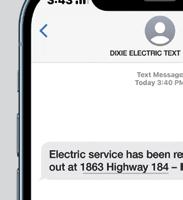


























As we close out another fiscal year, it is increasingly evident that East Mississippi Electric Power Association and East Mississippi Connect are our community’s trusted partners. The past year was filled with challenges, successes, opportunities, and strengthened relationships. The coming year will no doubt be more of the same. Many of the challenges we faced this year sound like another verse of the same song we have been singing for our 86 years of serving as your member-owned electric cooperative. Storms cut across our electric distribution system throughout the year and caused damage to poles, wires, transformers, services, and fiber. As they always do, our dedicated employees have been steady and reliable. Although we cannot control the weather, our job is to return normalcy to life after the storm.
Recognizing we cannot stop the storms, we can prepare for their impact. Each year, we spend numerous hours refining plans to strengthen the electric system. We invest an average of $8 million a year in electric system improvements, so when interruptions happen, we are ready to restore electric and fiber services as soon as humanly possible. While a 99.9% electric service reliability rate is great, we always look for a ordable options to improve and lower outage times. We do this while providing electric service on average for $3.50 per person per day. As we often say, that is less than a breakfast biscuit and a co ee.
Because of you, our members, we continue to see success with our fiber-to-the-home network. The mainline construction is complete, and the service installations continue to grow. When you gave us the charge to go into the broadband business, studies suggested that 12,500 members would take advantage of the new service. Today, over 14,100 members are enjoying high-speed internet access, lower landline phone cost, lower-cost TV streaming options, better cell








phone service via home Wi-Fi calling, and communication options only dreamed of just four years ago.
Technologies in both the electric system and the use of our fiber system provide opportunities for even better enhancement of our restoration times. The automated meter reading system notifies employees when interruptions happen, allowing mobilization of personnel more quickly. Enhanced breakers provide the data to determine probable locations of outages, and linemen use this data to see visually on maps where to begin looking for the cause. All this is done to shorten the response and restoration time and enhance your service.
Ultimately, what makes EMEPA successful is relationships. You, our members, are the primary relationship we value. In addition, we work with local, state, and national congressional delegates to tell our story and guard against policy changes that would negatively impact service delivery and a ordability.
Our mission is to deliver services that empower your lives. That mission aligns with our vision of building pathways for community success. With strong community and member relationships, quality employee relationships, and key political and business relationships, our future continues to be bright.

by Randy Carroll

SATURDAY, OCT. 5, 2024







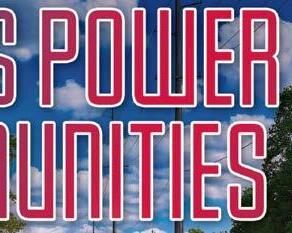



by Abby Berry
Communities come in all shapes and sizes. Some are based on geographical proximity; some are based on shared interests or hobbies, and some communities can even be found in virtual spaces like social media groups. Regardless of where or how they are formed, communities can bring people together and create a sense of belonging.
East Mississippi Electric Power Association is deeply committed to our consumer-members, and we’re glad you are part of the electric cooperative community.
This month, more than 30,000 cooperatives across the U.S. are celebrating National Co-op Month. It’s a time to reflect on all the aspects that set cooperatives apart from other types of businesses, but more importantly, it’s a time to celebrate the power of co-op membership.
Electric cooperatives are not-for-profit utilities that are built by the communities they serve. For East Mississippi Electric Power Association, our mission has always been to provide you with reliable power. We care about your quality of life, and because we are locally operated, we’re uniquely suited to meet our members’ evolving energy needs.
Beyond the business of electricity, our employees and directors are equally invested in our local community. Why? Because we live here, too. That’s why we work hard to support local economic development projects, youth programs and scholarships, charitable giving initiatives and additional programs that make our community a better place to call home.
All co-ops, including East Mississippi Electric Power Association, are guided by seven cooperative principles that embody the values and spirit of the cooperative movement.
These seven principles are a framework to help all co-ops navigate challenges and opportunities while remaining true to our purpose:
1. Open and Voluntary Membership: Co-op membership is open to anyone who can use the co-op’s services.
2. Democratic Member Control: Members make decisions that shape the cooperative. Why? Because co-ops are created by the members, for the members.
3. Members’ Economic Participation: Members contribute money to the co-op to make sure it runs smoothly now and in the future. At East Mississippi Electric Power Association, this happens through paying your energy bills and EMEPA’s return of capital credits to members on a 30-year rotation.
4. Autonomy and Independence: Co-ops are independent and can operate on their own, which ultimately benefits the members.
5. Education, Training, and Information: Co-ops continuously focus on education to ensure employees have the training and information they need to make the co-op successful.
6. Cooperation Among Cooperatives: Co-ops share with and learn from other cooperatives. We help each other out in times of need because we want other co-ops to thrive.
7. Concern for Community: All cooperatives work for the greater good of the local communities they serve. Co-ops give back to their communities to help them thrive and grow.
the




















































































EMEPA aids community success by promoting economic empowerment, fostering community engagement, and supporting the unique needs of our members. We partner with local organizations and other worthy programs to live out one of our core principles, “Concern for Community.”
Here are some ways we’re working for the sustainable development of our communities while providing safe, reliable, and a ordable power:
• We use technology to enhance our distribution system, thereby reducing outages and improving response times.
• We proactively trim trees to keep power lines clear from limbs that are likely to fall. Our continuous inspection of lines and vegetation allows us to bolster reliability by finding hot spots needing attention.
• We o er members the opportunity to donate monthly to their local volunteer fire departments. This year, members donated more than $43,000 through their monthly EMEPA bill.
• We sent Paisley Ivey of Clarke County; Clay Miles of Kemper County; Sam Nance and Erial Mays of Winston County; and Christian Hopson and Lily Ann Cooper of Lauderdale County on a weeklong trip to Washington, D.C., as part of the Cooperative Youth Leaders program.
• We hosted our 11th Annual Shoot For A Cure event raising $35,000 for the Anderson Cancer Center’s Cancer Patient Benevolence Fund and St. Jude’s Children’s Research Hospital.











• We awarded scholarships to five graduating high school seniors and one university transfer student through funding by the Electric Cooperatives of Mississippi Foundation.
• We partnered with the Tennessee Valley Authority (TVA) to secure a $10,000 grant each to Nanih Waiya Attendance Center and Noxapater Attendance Center for energy e cient upgrades through TVA’s Energy Right School Uplift program.
• We served more than 100 hours volunteering in the community for organizations such as State Games of MS, United Way of East Mississippi, Keep America Beautiful, Mississippi Children’s Museum – Meridian, and other local schools and organizations.
• We o er safety and energy e ciency education and demonstrations to schools and community organizations throughout the year.
• We proudly sponsor the Golden Apple Awards Program recognizing the impact of local educators on growing young leaders in our communities.
• We help restore power in other areas through mutual aid agreements with co-ops across the state and nation.
Ultimately, members empower EMEPA through membership and through participation in and support of these programs. Being community-focused is essential to everything we do.


































































































Strong, unique passwords are your first line of defense. Avoid easily guessable information like birthdays. Use a mix of uppercase and lowercase letters, numbers and special characters. A password manager can securely store and manage your passwords, so you only need to remember one master password.




October is Cybersecurity Awareness Month, highlighting the importance of online safety. As our lives become more digital—from remote work to online shopping—safeguarding personal information is crucial. At East Mississippi Connect, we’re committed to providing high-speed internet as well as the knowledge to keep you safe online. Here are some essential tips to protect your digital life.




Two-Factor Authentication, or 2FA, adds an extra layer of security by requiring a second verification step, such as a code sent to your phone, in addition to your password. Enable 2FA on important accounts like email, banking and social media to make it harder for cybercriminals to gain access.







Phishing scams are commonly used by cybercriminals to steal personal information. Be cautious of emails or messages that appear to be from legitimate sources but ask for sensitive information or direct you to suspicious websites. Verify the sender by contacting the company directly through their o cial channels.
Regular software updates are essential for online safety. Updates often include security patches that fix vulnerabilities in your operating system, web browser






























and other applications. Set your devices to update automatically to ensure you’re protected from malware and other cyber threats.
Your home network is your digital gateway, so keeping it secure is crucial. East Mississippi Connect internet includes ProtectIQ, a network-level security application that shields your home from malicious websites, viruses and intrusions 24/7. ProtectIQ uses a cloud database of known threats to protect all connected devices from cyberattacks, neutralizing these threats before they reach your network.


With the holiday season approaching, online shopping will be at an all-time high. Protect your financial information by shopping on secure websites that use “https” and display a padlock icon in the address bar. Avoid saving credit card information on websites and use a credit card with fraud protection whenever possible.


Cybersecurity is a family a air. Teach your children about online safety and the potential dangers they may encounter. Encourage open communication, so they feel comfortable coming to you with any suspicious messages or requests.




At East Mississippi Connect, your online safety is our priority. For more tips and resources, visit our website at EastMSConnect.com. Stay connected, stay safe!












































by Abby Berry
Communities come in all shapes and sizes. Some are based on geographical proximity; some are based on shared interests or hobbies, and some communities can even be found in virtual spaces like social media groups. Regardless of where or how they are formed, communities can bring people together and create a sense of belonging.
Magnolia Electric is deeply committed to our consumer-members, and we’re glad you are part of the electric cooperative community.
This month, more than 30,000 cooperatives across the U.S. are celebrating National Co-op Month. It’s a time to reflect on all the aspects that set cooperatives apart from other types of businesses, but more importantly, it’s a time to celebrate the power of co-op membership.
Electric cooperatives are not-for-profit utilities that are built by the communities they serve. For Magnolia Electric, our mission has always been to provide you with reliable power. We care about your quality of life, and because we are locally operated, we’re uniquely suited to meet our members’ evolving energy needs.
Beyond the business of electricity, our employees and directors are equally invested in our local community. Why? Because we live here, too. That’s why we work hard to support local economic development projects, youth programs and scholarships, charitable giving initiatives and additional programs that make our community a better place to call home.
All co-ops, including Magnolia Electric, are guided by seven cooperative principles that embody the values and spirit of the cooperative movement.
These seven principles are a framework to help all co-ops navigate challenges and opportunities while remaining true to our purpose:
1. Open and Voluntary Membership: Co-op membership is open to anyone who can use the co-op’s services.
2. Democratic Member Control: Members make decisions that shape the cooperative. Why? Because co-ops are created by the members, for the members.
3. Members’ Economic Participation: Members contribute money to the co-op to make sure it runs smoothly now and in the future. At Magnolia Electric, this happens through paying your energy bills.
4. Autonomy and Independence: Co-ops are independent and can operate on their own, which ultimately benefits the members.
5. Education, Training, and Information: Co-ops continuously focus on education to ensure employees have the training and information they need to make the co-op successful.
6. Cooperation Among Cooperatives: Co-ops share with and learn from other cooperatives. We help each other out in times of need because we want other co-ops to thrive.
7. Concern for Community: All cooperatives work for the greater good of the local communities they serve. Co-ops give back to their communities to help them thrive and grow.


















QDo you have any tips on finding hidden energy savings in my home?
by Miranda Boutelle
Using your attic for storage can be problematic when trying to maximize your home’s energy e ciency. Let’s explore how you can improve insulation levels and properly store items in your attic.
Attic insulation is one of the best low-cost ways to make your home e cient. People often associate insulation with keeping your home warmer in the winter, but it also provides benefits in the summer. Insulation reduces heat transfer from the attic to the house, which lowers energy bills for air conditioning and makes your home more comfortable.
AI’ve been in a lot of homes. One common hiding spot for energy savings is the attic. It is also a common location for storing holiday decorations and infrequently used sentimental items.
Attic insulation is measured in R-value, which is a measurement of how well a material resists the flow of heat. For attic insulation, thicker is better. The recommended R-value is typically between R-38 and R-60, depending on your climate. Hawaii and the southernmost tips of Florida and Texas recommend R-30. Measured in inches, that ranges from around 10 to 20 inches, depending on the type of insulation you have. In most homes, the ceiling joists are buried in insulation to achieve the recommended R-value.
The problem with attic storage is it typically doesn’t o er enough space for the recommended R-value. Often, plywood or boards are placed directly on top of the ceiling joists, which isn’t enough space for the insulation. Insulation can get compacted by people moving items in or out, reducing the e ective R-value.
Ideally, the attic would not be used for storage so it can be properly insulated, but that’s not feasible for everyone. Here are some strategies for maintaining attic storage and recommended insulation levels.
The best location for attic storage is over an unconditioned area of your home, such as the garage. You don’t need insulation in attic spaces over a garage or unconditioned area because you are not heating or cooling the space below. This makes it the perfect spot to tuck away items for storage.
If that isn’t an option, consider minimizing the number of stored items or the storage area’s footprint. A great way to do this is by building an attic storage platform. A raised platform allows the space underneath it to be fully insulated. These platforms are available in ready-to-install kits, or you can buy materials and build them yourself.

Your attic might also have trusses that allow you to build shelves and maximize space by storing items vertically.
Allow enough space underneath the platform to achieve the proper R-value. Use lumber to build a frame perpendicular to the existing joists and cover it with plywood or oriented strand board. Once your storage area is set up, add insulation inside the platform to bring the R-value up to the proper level.
Your attic might also have trusses that allow you to build shelves and maximize space by storing items vertically.
Always wear a dust mask or respirator when working in the attic. Don’t forget to weatherstrip the attic hatch to ensure a tight seal. Take a look around your attic to see if you can find any hidden opportunities for energy savings.
Miranda Boutelle is the chief operating o cer at E ciency Services Group in Oregon, a cooperatively owned energy e ciency company.






















With early predictions for Hurricane Francine’s eye to come directly over Pike County, the sta at Magnolia Electric Power were preparing for the worst.
But thankfully, early on Sept. 12, the “eye passed to the east of Pike County in the morning hours,” according to o cials with the National Oceanic and Atmospheric Association Weather Service (NOAA), through an email to Pike County Emergency Management.
“McComb Airport had a peak wind gust of 35 mph and another automated gauge in northern Pike County recorded a 31-mph wind gust. Based on that information, winds peaked in the 30 to 40 mph range,” NOAA o cials said.
The weather service added, “Some beneficial rainfall also occurred with this hurricane. Summit, Mississippi recorded the highest total at 2.29 inches, and most of (Pike) county received between 1.5 and 2.5 inches of rainfall.”
In the aftermath of the hurricane, which was later downgraded to a tropical storm, MEP reported 2,301 meters without power in their 6 a.m. Facebook report.
Although the outage number was low for a hurricane, the MEP sta worked in “storm mode” on Sept. 12 and went to work restoring power. Those contractors, who had already been called in for the event, worked the outages alongside MEP’s linemen.





There was minimal damage to the MEP electrical grid, and the
There was minimal damage to the MEP electrical grid, and the damage that occurred was due to limbs and dead pine trees that had fallen on powerlines. There were no broken poles to report.
The lineman had to work in misting rain and mud but were able to get all power restored to the meters that could take power by 6:20 p.m.



























by Abby Berry


Communities come in all shapes and sizes. Some are based on geographical proximity; some are based on shared interests or hobbies, and some communities can even be found in virtual spaces like social media groups. Regardless of where or how they are formed, communities can bring people together and create a sense of belonging.
Monroe County Electric is deeply committed to our consumermembers, and we’re glad you are part of the electric cooperative community.
This month, more than 30,000 cooperatives across the U.S. are celebrating National Co-op Month. It’s a time to reflect on all the aspects that set cooperatives apart from other types of businesses, but more importantly, it’s a time to celebrate the power of co-op membership.
Electric cooperatives are not-for-profit utilities that are built by the communities they serve. For Monroe County Electric, our mission has always been to provide you with reliable power. We care about your quality of life, and because we are locally operated, we’re uniquely suited to meet our members’ evolving energy needs.
Beyond the business of electricity, our employees and directors are equally invested in our local community. Why? Because we live here, too. That’s why we work hard to support local economic development projects, youth programs and scholarships, charitable giving initiatives and additional programs that make our community a better place to call home.
All co-ops, including Monroe County Electric, are guided by seven cooperative principles that embody the values and spirit of the cooperative movement.
These seven principles are a framework to help all co-ops navigate challenges and opportunities while remaining true to our purpose:
1. Open and Voluntary Membership: Co-op membership is open to anyone who can use the co-op’s services.
2. Democratic Member Control: Members make decisions that shape the cooperative. Why? Because co-ops are created by the members, for the members.
3. Members’ Economic Participation: Members contribute money to the co-op to make sure it runs smoothly now and in the future. At Monroe County Electric, this happens through paying your energy bills.
4. Autonomy and Independence: Co-ops are independent and can operate on their own, which ultimately benefits the members.
5. Education, Training, and Information: Co-ops continuously focus on education to ensure employees have the training and information they need to make the co-op successful.
6. Cooperation Among Cooperatives: Co-ops share with and learn from other cooperatives. We help each other out in times of need because we want other co-ops to thrive.
7. Concern for Community: All cooperatives work for the greater good of the local communities they serve. Co-ops give back to their communities to help them thrive and grow.
This October, as we celebrate National Co-op Month and the power of membership, we hope you will recognize the many aspects that set electric cooperatives apart. Our mission is reliable power. Our purpose is people — the local communities we’re proud to serve.
Abby Berry writes on consumer and cooperative a airs for the National Rural Electric Cooperative Association.
Monroe County Electric Power Association held its annual meeting on Tuesday, August 6, 2024. During this meeting the board of director election results were announced. The membership of MCEPA reelected Avery Duncan, Jr and Brenda Willis in District 4 and elected Steven Reeves in District 5. There was a total of 695 votes returned to the accounting firm of Franks, Franks, Wilemon and Hagood. The board terms begin Sept. 1, 2024, and will run for three years.


















QDo you have any tips on finding hidden energy savings in my home?
by Miranda Boutelle
Using your attic for storage can be problematic when trying to maximize your home’s energy e ciency. Let’s explore how you can improve insulation levels and properly store items in your attic.
Attic insulation is one of the best low-cost ways to make your home e cient. People often associate insulation with keeping your home warmer in the winter, but it also provides benefits in the summer. Insulation reduces heat transfer from the attic to the house, which lowers energy bills for air conditioning and makes your home more comfortable.
AI’ve been in a lot of homes. One common hiding spot for energy savings is the attic. It is also a common location for storing holiday decorations and infrequently used sentimental items.
Attic insulation is measured in R-value, which is a measurement of how well a material resists the flow of heat. For attic insulation, thicker is better. The recommended R-value is typically between R-38 and R-60, depending on your climate. Hawaii and the southernmost tips of Florida and Texas recommend R-30. Measured in inches, that ranges from around 10 to 20 inches, depending on the type of insulation you have. In most homes, the ceiling joists are buried in insulation to achieve the recommended R-value.
The problem with attic storage is it typically doesn’t o er enough space for the recommended R-value. Often, plywood or boards are placed directly on top of the ceiling joists, which isn’t enough space for the insulation. Insulation can get compacted by people moving items in or out, reducing the e ective R-value. Ideally, the attic would not be used for storage so it can be properly insulated, but that’s not feasible for everyone. Here are some strategies for maintaining attic storage and recommended insulation levels.
The best location for attic storage is over an unconditioned area of your home, such as the garage. You don’t need insulation in attic spaces over a garage or unconditioned area because you are not heating or cooling the space below. This makes it the perfect spot to tuck away items for storage.
If that isn’t an option, consider minimizing the number of stored items or the storage area’s footprint. A great way to do this is by building an attic storage platform. A raised platform allows the space underneath it to be fully insulated. These platforms are available in ready-to-install kits, or you can buy materials and build them yourself.

Your attic might also have trusses that allow you to build shelves and maximize space by storing items vertically.
Allow enough space underneath the platform to achieve the proper R-value. Use lumber to build a frame perpendicular to the existing joists and cover it with plywood or oriented strand board. Once your storage area is set up, add insulation inside the platform to bring the R-value up to the proper level.
Your attic might also have trusses that allow you to build shelves and maximize space by storing items vertically.
Always wear a dust mask or respirator when working in the attic. Don’t forget to weatherstrip the attic hatch to ensure a tight seal. Take a look around your attic to see if you can find any hidden opportunities for energy savings.
Miranda Boutelle is the chief operating o cer at E ciency Services Group in Oregon, a cooperatively owned energy e ciency company.





















by Abby Berry
Did you know the average household with internet access owns about 17 connected devices? That figure covers a wide range of electronics, including smart phones, computers, streaming devices, smart speakers, home assistants, and more. Given our increasing reliance on internet-connected technologies, the likelihood of new cyber threats is ever-present.
Monroe County Electric is deeply committed to ensuring our local system is safe and secure. We routinely monitor and manage cyber risks, and we work together with other co-ops to share the latest advancements in cybersecurity measures that make us stronger. But you can help, too.






When we all work together to stay safe online, we lower the risk of cyber threats to our systems, online accounts, and sensitive data.
October is National Cybersecurity Month, and while good cyber hygiene should be practiced year-round, we’d like to share a few cybersecurity tips to help you bolster your online safety.
Let’s all do our part to stay cyber smart and create a safer digital world for all. Visit staysafeonline.org to learn about additional cybersecurity tips.
Abby Berry writes on consumer and cooperative a airs for the National Rural Electric Cooperative Association.

Learn how to spot and report phishing attempts. Phishing occurs when criminals use phony emails, direct messages or other types of digital communications that lure you to click a bad link or download a malicious attachment. If you receive a suspicious email or message that includes urgent language, o ers that seem too good to be true, generic greetings, poor grammar, or an unusual sender address, it could be a phishing attempt. If you spot one, report it as soon as possible — and don’t forget to block the sender. (If you receive a suspicious work email, report it to the appropriate IT contact. Suspicious messages that are delivered to your personal email or social media accounts can also be reported.)
Create strong, unique passwords. When it comes to passwords, remember that length trumps complexity. Strong passwords contain at least 12 characters and include a mix of letters, numbers, and symbols. Create unique passwords for each online account you manage and use phrases you can easily remember.
Enable multi-factor authentication when available. Multi-factor authentication (also known as 2-factor authentication) adds an extra layer of security to your online accounts. These extra security steps can include facial recognition, fingerprint access, or one-time codes sent to your email or phone.
Update software regularly. Software and internet-connected devices, including personal computers, smartphones, and tablets, should always be current on updates to reduce the risk of infection from ransomware and malware. When possible, configure devices to automatically update or notify you when an update is available.
































by Abby Berry
Communities come in all shapes and sizes. Some are based on geographical proximity; some are based on shared interests or hobbies, and some communities can even be found in virtual spaces like social media groups. Regardless of where or how they are formed, communities can bring people together and create a sense of belonging.
Natchez Trace Electric is deeply committed to our consumermembers, and we’re glad you are part of the electric cooperative community.
This month, more than 30,000 cooperatives across the U.S. are celebrating National Co-op Month. It’s a time to reflect on all the aspects that set cooperatives apart from other types of businesses, but more importantly, it’s a time to celebrate the power of co-op membership.
Electric cooperatives are not-for-profit utilities that are built by the communities they serve. For Natchez Trace Electric, our mission has always been to provide you with reliable power. We care about your quality of life, and because we are locally operated, we’re uniquely suited to meet our members’ evolving energy needs.
Beyond the business of electricity, our employees and directors are equally invested in our local community. Why? Because we live here, too. That’s why we work hard to support local economic development projects, youth programs and scholarships, charitable giving initiatives and additional programs that make our community a better place to call home.
All co-ops, including Natchez Trace Electric, are guided by seven cooperative principles that embody the values and spirit of the cooperative movement.
These seven principles are a framework to help all co-ops navigate challenges and opportunities while remaining true to our purpose:
1. Open and Voluntary Membership: Co-op membership is open to anyone who can use the co-op’s services.
2. Democratic Member Control: Members make decisions that shape the cooperative. Why? Because co-ops are created by the members, for the members.
3. Members’ Economic Participation: Members contribute money to the co-op to make sure it runs smoothly now and in the future. At Monroe County Electric, this happens through paying your energy bills.
4. Autonomy and Independence: Co-ops are independent and can operate on their own, which ultimately benefits the members.
5. Education, Training, and Information: Co-ops continuously focus on education to ensure employees have the training and information they need to make the co-op successful.
6. Cooperation Among Cooperatives: Co-ops share with and learn from other cooperatives. We help each other out in times of need because we want other co-ops to thrive.
7. Concern for Community: All cooperatives work for the greater good of the local communities they serve. Co-ops give back to their communities to help them thrive and grow.
























EXPERIENCE is the third component in the Cooperative Youth Leaders program. Eighty-five rising high school seniors from across Mississippi traveled to Washington, D.C., to experience all facets of their nation’s capital city.
They visited, for a full week in June, along with nearly 1,700 student leaders from 44 states for the 2024 National Rural Electric Cooperative Association’s Youth Tour.
The trip was the culmination of the students’ participation in the Electric Cooperatives of Mississippi’s leadership program, which instills leadership skills, inspires creative thinking, builds confidence in decision-making, and introduces students to lawmakers that represent their communities.
During a March workshop in Jackson, which is the GROW component of the program, the students had the opportunity to meet and hear from state legislators. During the trip to Washington, D.C., the students met and spoke with their U.S. senators — Roger Wicker and Cindy Hyde-Smith.






While in Washington, D.C., the students and adult chaperones visited historic sites, monuments, museums, and had an opportunity to learn about the impact electric cooperatives have on their communities.
The students also had an opportunity to tour the U.S. Capitol, sit on the floor of the House of Representatives, and visit the Library of Congress as guests of former U.S. Congressman Gregg Harper of Mississippi.
The students attended a Washington Nationals pro baseball game and had dinner during an evening cruise on the Potomac River.
The students were chosen in the fall of their junior year of high school through their local Cooperative University and interviews, where they LEARNed about their electric cooperative and the electric power industry.
The Cooperative Youth Leaders program is fully funded — including the trip to D.C. — by the local electric co-ops as a commitment to molding future leaders for Mississippi, so they can impact the state and local communities.









The entire trip was a blast!
The Natural History Museum and American History Museum taught us new knowledge of our country and its origin. – Emily Torres and JuKarion Conner
CALHOUN CITY HIGH SCHOOL
CALHOUN CITY HIGH SCHOOL












SUNDAY, JUNE 16 EINSTEIN MEMORIAL











TUESDAY, JUNE 18 THE WHITE HOUSE




WEDNESDAY, JUNE 19


U.S. CAPITOL STEPS


















THURSDAY, JUNE 20 THE KENNEDY CENTER







FRIDAY, JUNE 21

WASHINGTON NATIONAL CATHEDRAL










by John N. Felsher
Ask any hardcore crappie anglers to name their dream lake for catching big fish and most would unhesitatingly say Grenada Lake.
“Grenada Lake has always been known for producing giant crappie,” said John Harrison with JH Guide Service (662-9835999, Facebook) in Calhoun City and a long-time member of the Natchez Trace Electric Power Association. Harrison has lived in the area for 53 years and been a guide on Grenada Lake since 2001. “The biggest one I’ve ever caught and put on a scale weighed 3.69 pounds.”
One of the “Big Four” U.S. Army Corps of Engineers flood control reservoirs in northern Mississippi, Grenada Lake produced some four-pound crappie and numerous threepounders over the years. The largest lake entirely within the Magnolia State spreads across more than 35,000 acres at pool stage near the town of Grenada.
“Grenada Lake is probably one of the better lakes in the country to catch a big crappie,” Keith Meals, a Mississippi Department of Wildlife, Fisheries, and Parks biologist said.
“Grenada Lake produces many 2- to 2.5-pound fish with the biggest crappie in many tournaments often coming in around 3.5 pounds or better. It produced some four pounders in 2022.”
Impounded on the Yalobusha River, the principal tributary to the Yazoo River, Grenada Lake dates to 1954. The name comes from the Choctaw word “yalooboshi,” meaning “little tadpole.” The Skuna River flows into the northern end of the reservoir.
People can catch big crappie all year long on Grenada Lake, but many people fish it in the spring for big spawners. However, the fall can provide fantastic fishing as well.
“I always look forward to fall fishing on Grenada Lake,” Harrison said. “As cooler temperatures arrive and water starts falling, the fish go on a feeding binge to feed up for the winter. By November, the crappie get butterball fat from chasing after the shad. Shad are abundant in these Big Four lakes.”
Beginning in August each year, the Corps begins to draw down the lake. The lake begins to refill in mid-January. It normally reaches full pool by early May. Falling water exposes abundant stumps, fallen trees and other structures. People could load a boat by dropping baits next to these objects.








“As the water continues to fall, fish cling to those stumps,” Harrison said. “In the fall, I fish with live minnows or jigs and just move the boat slowly forward. Drop a jig or a live minnow vertically right next to those stumps and anything else sticking out of the water. A minnow under a cork also works well.”
By November, people cannot launch most boats into Grenada Lake. Some people use this time to fish from canoes or kayaks. When the water gets too low, many people fish the river tailrace below the dam. Water flowing over the spillway concentrates baitfish and sparks feeding activity.
“I’ve seen some big fish come out of the spillway, which means they were probably pulled out of the lake,” Meals acknowledges. “The spillway is one of the places where bank anglers can catch good fish.”
Many people stand on the rocks or the bank casting jigs or corks with minnows. Bank anglers can also fish several places on the main lake. Many people fish the Butputter Creek, Dry Branch and Turkey Creek areas.
People can fish with confidence and know that their electrical needs are met by Natchez Trace EPA. “I love the people at Natchez Trace EPA,” Harrison said. “Many of the people who work there are my friends. I’ve been with Natchez Trace EPA for a long, long time and haven’t had any problems. They’re very dependable.”

















The 74th Annual Meeting of Northcentral Electric Cooperative is taking place this month. Having this business meeting during National Cooperative Month and Public Power Month demonstrates the strength of the co-op and public power model. Board representation will be elected; operational reports will be presented, and the community will have opportunities to pose questions and voice concerns.
Earlier this summer an increase in rates was presented. TVA has raised wholesale rates to Northcentral by 4.5%. Northcentral had planned to raise our rates 2.5% to accommodate inflation and increased interest rates. This 2.5% was later reduced to 2%. We were able make this reduction due an anticipated benefit of $850,000 in reduced power costs in connection with power purchased from Silicon Ranch’s Byhalia solar project. Lower TVA fuel costs ease the burden as well. October rates will be approximately 3.67% higher than last year. Contractually, TVA will not be able to raise rates again until 2029. That, combined










with an ease in inflation and interest, will hopefully be enough to keep rates somewhat more stable next year.
Safety, reliability, and a ordability are the top priorities of your cooperative. Northcentral is consistently a top performer in safety and reliability and remains in the bottom 20% nationally in rates among electric cooperatives. After 74 years we still intend to work harder than ever to serve and improve the quality of life in our community. Stay safe.

by Kevin Doddridge General Manager/CEO










by Abby Berry
Communities come in all shapes and sizes. Some are based on geographical proximity; some are based on shared interests or hobbies, and some communities can even be found in virtual spaces like social media groups. Regardless of where or how they are formed, communities can bring people together and create a sense of belonging.
Northcentral Electric Cooperative is deeply committed to our consumer-members, and we’re glad you are part of the electric cooperative community.
This month, more than 30,000 cooperatives across the U.S. are celebrating National Co-op Month. It’s a time to reflect on all the aspects that set cooperatives apart from other types of businesses, but more importantly, it’s a time to celebrate the power of co-op membership.
Electric cooperatives are not-for-profit utilities that are built by the communities they serve. For Northcentral, our mission has always been to provide you with reliable power. We care about your quality of life, and because we are locally operated, we’re uniquely suited to meet our members’ evolving energy needs.
Beyond the business of electricity, our employees and directors are equally invested in our local community. Why? Because we live here, too. That’s why we work hard to support local economic development projects, youth programs and scholarships, charitable giving initiatives and additional programs that make our community a better place to call home.
All co-ops, including Northcentral Electric Cooperative, are guided by seven cooperative principles that embody the values and spirit of the cooperative movement.
These seven principles are a framework to help all co-ops navigate challenges and opportunities while remaining true to our purpose:
1. Open and Voluntary Membership: Co-op membership is open to anyone who can use the co-op’s services.
2. Democratic Member Control: Members make decisions that shape the cooperative. Why? Because co-ops are created by the members, for the members.
3. Members’ Economic Participation: Members contribute money to the co-op to make sure it runs smoothly now and in the future. At Northcentral Electric Cooperative, this happens through paying your energy bills.
4. Autonomy and Independence: Co-ops are independent and can operate on their own, which ultimately benefits the members.
5. Education, Training, and Information: Co-ops continuously focus on education to ensure employees have the training and information they need to make the co-op successful.
6. Cooperation Among Cooperatives: Co-ops share with and learn from other cooperatives. We help each other out in times of need because we want other co-ops to thrive.
7. Concern for Community: All cooperatives work for the greater good of the local communities they serve. Co-ops give back to their communities to help them thrive and grow.






If you’re an 11th grader, make this year memorable by participating in the 2025 Cooperative Leaders Workshop in Jackson, Miss., and Youth Tour of Washington, D.C.
Washington National Cathedral | Jefferson, FDR, MLK Memorials | World War II Memorial Arlington National Cemetery | Iwo Jima Memorial | Vietnam Veterans Memorial







Northcentral Electric Cooperative safety coordinator Joel Barrett has completed an intensive program in electric utility safety and loss control. The Certified Loss Control Program is a series of workshops o ered by the National Rural Electric Cooperative Association in conjunction with the National Utility Training & Safety Education Association. The program is designed to instruct participants in many areas related to electric utility industry safety.
According to the Occupational Safety and Health Administration (OSHA), nearly 4 million injuries occur annually in the workplace. One of the goals of a Certified Loss Control Professional is to help ensure a safe work environment for utility workers and the public in general. Avoiding workplace accidents avoids down time and can ultimately lead to lower utility rates.
Barrett is one of only a few electric utility professionals in the country that will receive this certification this year. The program requires participants to complete a rigorous series of seminars and tests, a 30-hour OSHA course, and a detailed final course project.
Loss Control participants go through four, week-long sessions that are designed to challenge and educate participants in new, innovative safety techniques. Participants must also maintain their certificate by attending courses every year in order to stay on top of changes in the industry.
Barrett joined Northcentral in late 2002 and has first-hand knowledge of utility line work, having advanced to his current role after serving the cooperative’s members as a lineman for over 16 years.





























Member owned. Locally operated. That’s the cooperative difference. • Visit us online at



COLUMBIA: 601-736-2666 | HATTIESBURG: 601-264-2458 | PURVIS: 601-794-8051 | WIGGINS: 601-928-7277





As October unfolds, we at Pearl River Valley Electric Power Association join hundreds of other electric cooperatives across the nation in celebrating National Co-op Month. This annual observance serves as a powerful reminder of the unique value cooperatives bring to our communities, driven by the seven cooperative principles. These principles are not just lofty ideals; they are the bedrock of how we operate and serve our members every day.
1. VOLUNTARY AND OPEN MEMBERSHIP
At Pearl River Valley Electric, membership is open to everyone who can use our services. This approach ensures that our cooperative remains a community-driven organization, where each member has an equal opportunity to benefit from our services.
2. DEMOCRATIC MEMBER CONTROL
Democratic control is the heartbeat of our cooperative. Our members actively participate in setting policies and making decisions. Pearl River Valley Electric is governed by a board of directors elected from our membership. This means every member has a voice and a vote in how we operate. Members have the opportunity to attend our annual meeting held every fourth Saturday in September.
3. MEMBERS’ ECONOMIC PARTICIPATION
Economic participation is a principle that sets cooperatives apart from traditional businesses. At Pearl River Valley Electric, our members contribute equitably to, and democratically control, the capital of the cooperative. Surplus revenues are returned to the members in the form of capital credits, ensuring that the financial benefits of the cooperative are shared among those who use its services. Recently, Pearl River Valley Electric returned $3.6 million in capital credits. In total, we have returned $75 million.
4. AUTONOMY AND INDEPENDENCE
While Pearl River Valley Electric collaborates with other cooperatives and organizations, we remain autonomous and independent. This principle allows us to maintain control over our operations, ensuring that decisions are made locally and with the best interests of our members in mind. We are proud to be a cooperative that is owned and operated by the people we serve.
5. EDUCATION, TRAINING, AND INFORMATION
We believe that an informed membership is a powerful membership. Pearl River Valley Electric is committed to providing education and training to our members, employees, and the broader community. Whether it is through education about energy
e ciency and safety, or providing resources about solar power, we empower our members with the knowledge they need to make informed decisions about their energy use.
6. COOPERATION AMONG COOPERATIVES
Cooperation among cooperatives is more than just a principle; it is a practice we embrace daily. Pearl River Valley Electric partners with other cooperatives to share resources, knowledge, and innovations. By working together, we strengthen the cooperative network and enhance the services we provide to our members.
7. CONCERN FOR COMMUNITY
At the heart of Pearl River Valley Electric’s mission is a deep concern for our community. We are more than just an electric provider; we are a community partner. We invest in the future of our community through our Round up for Education scholarships, Sharing Success grants, and food and school supply drives, ensuring that the communities we serve are vibrant and thriving. In 2021, we saw the need to improve our members lives by bringing high-speed fiber internet to our service territory. We created a subsidiary company, PearlComm Fiber, which now boasts nearly 15,000 customers.
As we celebrate Co-op Month, we reflect on how these seven principles guide every decision we make at Pearl River Valley Electric. They are the foundation of our commitment to providing reliable and a ordable energy to our members and improving the communities we live in. We are proud to be a cooperative that not only powers homes and businesses but also empowers communities and enhances lives. This October, we invite you to celebrate with us and take pride in being part of something truly special.

by Matthew Ware
CEO/General Manager

• Organized in May 1938
• Governing body is a 10-member Board of Directors elected by members for staggered 3-year terms
• Service area includes all or parts of 12 counties
• Serves more than 53,000 meters consisting of residential, commercial, large power, and industrial loads
• Electric distribution system includes more than 6,300 miles of power lines and 24 substations.
• Headquarters is located in Columbia, with district o ces in Hattiesburg, Wiggins, and Purvis.
• Employs approximately 130 highly skilled, service-oriented professionals
• In 1963, PRVEPA was the first cooperative in Mississippi to begin paying patronage refunds (a return on members’ equity in the Association). Since that time, nearly $75 million has been returned to members over the course of over 60 years.
• In 1988, PRVEPA began returning patronage credits to the estates of deceased members — more than $19.3 million has been returned through that program.









Pearl River Valley Electric is excited to have area high school juniors participate in our Cooperative Youth Leaders program. If you are an 11th grader served by Pearl River Valley Electric Power Association, check with your guidance counselor about this life-changing program.
Every year, Pearl River Valley Electric chooses two students to represent the cooperative at a leadership workshop in Jackson and for a week-long tour of Washington, D.C. in June. Pearl River Valley Electric’s Cooperative University is the first step in the Electric Cooperatives of Mississippi’s youth leadership program, which has been ongoing for 38 years.
The Cooperative University is a one-day event where each school within PRVEPA’s service territory will be represented by two students. Each student is expected to attend the all-day event in its entirety. The day will consist of speakers, games, lunch, and various demonstrations. This year’s Cooperative University will be held on Nov. 6 at the National Guard Armory in Columbia, beginning at 8:30 a.m. and concluding by 3:30 p.m.
At PRVEPA’s Cooperative University, students will learn about Pearl River Valley Electric and what it means to be a member. They will learn how electric cooperatives began, how electricity is produced and much more. Each student will also participate in an interview process by a panel of judges to be one of two students chosen for the leadership program.
Home school students are also encouraged to apply. Please call 601-731-7830 for more information.


Paying your bill has never been easier. You can now pay your Pearl River Valley Electric bill by text anytime, from anywhere with your smartphone (or your old flip phone).


STEP 1 If you aren’t already enrolled in text alerts, simply text “Join” to #352667.
STEP 2 When you receive your welcome text, choose “start.”
STEP 3 If you haven’t done so, set up a payment profile in our member portal through our website www.prvepa.com or through our app.

















































































































EmPowered, our online customer portal at www.prvepa.com, and our PRVEPA app allow you the opportunity to view your billing history, daily kilowatt hour use, and past bills. In addition, they make it easy to report outages, make a payment, and sign up for paperless billing.
Pearl River Valley Electric members can easily pay their bill online at www.prvepa.com or through the PRVEPA app by credit card, debit card, or e-check. There is no service fee to pay online. To make your payment online, simply visit www.prvepa.com and click on the “Pay My Bill” icon located on the homepage. To pay by app, please download the app and click “pay now.”
The Pearl River Valley Electric Outage Viewer is available to our members 24-7. When there’s an outage anywhere in PRVEPA territory, members can locate it, find out how many members are a ected, and follow the progress of the restoration e ort. Find the outage viewer map by going to www.prvepa.com and clicking on the “Report an Outage” icon on the homepage.























Pearl River Valley Electric’s Bank Draft program is the most convenient way to pay your power bill. It also gives you the security of knowing your power bill will be paid on time. Eliminate the hassle of mailing a check or driving to the o ce.
Sign up for Bank Draft from the comfort of your home!
Visit www.prvepa.com and login to your EmPowered account. Go to the Billing and Payments menu and choose “Draft Payments.” Fill in your banking or credit card information. You can also choose pay by draft or auto pay in the app under the “Payments” button.
Social media gives Pearl River Valley Electric the chance to connect to its members. Through Facebook and Twitter, we post information on energy e ciency, safety, and special information for our members. Additionally, during severe weather, these sites provide instant communications on storm preparation and outages.

Pearl River Valley Electric employees gathered school supplies for area schools to help power education for students. Employees made deliveries to East and West Marion Elementaries, the Baxterville School, Dixie Attendance Center, and Stone and Perkinston Elementaries. Supplies included crayons, pencils, notebook paper, scissors, and glue sticks. We wish all the students a great school year!























by Abby Berry
Did you know the average household with internet access owns about 17 connected devices? That figure covers a wide range of electronics, including smart phones, computers, streaming devices, smart speakers, home assistants, and more. Given our increasing reliance on internet-connected technologies, the likelihood of new cyber threats is ever-present.
Pearl River Valley Electric is deeply committed to ensuring our local system is safe and secure. We routinely monitor and manage cyber risks, and we work together with other co-ops to share the latest advancements in cybersecurity measures that make us stronger. But you can help, too.






When we all work together to stay safe online, we lower the risk of cyber threats to our systems, online accounts, and sensitive data.
October is National Cybersecurity Month, and while good cyber hygiene should be practiced year-round, we’d like to share a few cybersecurity tips to help you bolster your online safety.
Let’s all do our part to stay cyber smart and create a safer digital world for all. Visit staysafeonline.org to learn about additional cybersecurity tips.
Abby Berry writes on consumer and cooperative a airs for the National Rural Electric Cooperative Association.

Learn how to spot and report phishing attempts. Phishing occurs when criminals use phony emails, direct messages or other types of digital communications that lure you to click a bad link or download a malicious attachment. If you receive a suspicious email or message that includes urgent language, o ers that seem too good to be true, generic greetings, poor grammar, or an unusual sender address, it could be a phishing attempt. If you spot one, report it as soon as possible — and don’t forget to block the sender. (If you receive a suspicious work email, report it to the appropriate IT contact. Suspicious messages that are delivered to your personal email or social media accounts can also be reported.)
Create strong, unique passwords. When it comes to passwords, remember that length trumps complexity. Strong passwords contain at least 12 characters and include a mix of letters, numbers, and symbols. Create unique passwords for each online account you manage and use phrases you can easily remember.
Enable multi-factor authentication when available. Multi-factor authentication (also known as 2-factor authentication) adds an extra layer of security to your online accounts. These extra security steps can include facial recognition, fingerprint access, or one-time codes sent to your email or phone.
Update software regularly. Software and internet-connected devices, including personal computers, smartphones, and tablets, should always be current on updates to reduce the risk of infection from ransomware and malware. When possible, configure devices to automatically update or notify you when an update is available.






















PONTOTOC 662-489-3211 • Fax: 662-489-5156
P.O. Drawer 718 • 12 South Main Street, Pontotoc, MS 38863




by Jennifer Johnson

662-983-2727 • Fax: 662-983-1335
P.O. Box 415 • 129 South Newberger Street, Bruce, MS 38915

PEPA Staking/GIS Mapping Technician Ramon Tillman has always been intrigued by electricity. As a boy, Tillman said he can remember switching the lights on and o and wondering how that happened.
As he grew up and entered high school, he was looking for a future career choice. He was undecided between electrical engineering and physical therapy. He thought back on his childhood and how he was fascinated by electronics. The choice was obvious: he would study to become an electrical engineer.
And that’s just what he did. Tillman graduated from the University of Mississippi with an electrical engineering degree while working parttime for Pontotoc Electric in the engineering department.
Tillman grew up in Pittsboro, MS and graduated from Bruce High School. Although he played sports in high school, Tillman said he considers himself more of a “gamer." He especially enjoys playing “Call of Duty.” He said it’s a good way to relax. “I consider it a stress reliever, an escape from the problems of the real world.”
He said he has always liked lifting weights, and he looks forward to an occasional pick-up game of basketball or football.
Tillman’s family includes mom Ramona, who retired as the Calhoun County Chancery Clerk, and brothers Sedric, a travel nurse, and Deshaun, a physical trainer. His grandfather Raymond Tillman is also an important part of his life. Tillman said the two have always been close. “Every summer I would go to his house and help him all summer. We used to go fishing together. He taught me a lot over the years. He was always doing something – always working – but he taught me there is
more to life than work. He taught me how to be a man,” he said.
Tillman is complimentary of his work family too. “PEPA is a great place to work. I’ve made a lot of great friends. People are good about extending a hand to help you learn, and I’ve learned a lot.”



He spent several months working with the PEPA line crews to better understand the industry. Tillman said the experience was invaluable. “They helped me with my drawings and showed me how it’s all tied together as far as the di erent departments.”
One of his favorite memories during that time was a sunny, 100-degree day when he was assisting the crews who were restoring power in an area. “We were working hard to get the lights back on. When that happened, we made a lot of people happy. That felt good.”
Tillman said he hopes to gain more responsibility in the company in the future. He wants to “be on top of my game so I can help others." He said operating his own side business in the electrical field someday is something he is excited about.
For now, Tillman is enjoying his role and learning more all the time. His advice for a student looking to go into the field of engineering? “Find someone who does that work and knows the ins and outs. Try to get some hands-on work experience to make sure that is what you want to do.”








by Jennifer Johnson
When PEPA Member Amanda Dodd She eld married her junior high/high school/college sweetheart Chris in 2002, they were excited to see what God had in store. Daughter, and PEPA's 2023 Cooperative Youth Leader, Mollie, came along a few years later, followed by son, Eli. The children were growing up, playing sports and other activities. Amanda was happily soaking in family life.
But in September 2023, life threw the She elds a curve. Amanda had just left her mammogram appointment. “Before I got back to Highway 45, my doctor’s o ce was calling saying they had found an abnormality.”
She eld said the doctor’s o ce had already made an appointment at the breast care center in Tupelo for the next day. At first, she decided not to share the information with her family. Chris, an industrial electrician, was in class more than four hours hours away and had an exam to take later that week. She wondered how she would explain this to her kids.
“The next day, I called a friend and told her the doctor had seen some spots that were cancerous. I told her they wanted me to see a surgeon for a biopsy,” Amanda said.
Late that Thursday afternoon, She eld decided it was time to let her husband know. “I face timed him. Chris told her he had a friend whose wife worked for a surgeon." They got in touch with her and the next step was an appointment with Dr. Danny Sanders the following Monday to perform the biopsy.
She eld, who works for a company called Claims Professionals Liability Insurance Company out of Charlotte, North Carolina, had a conference coming up the next week. When she had the biopsy done,






















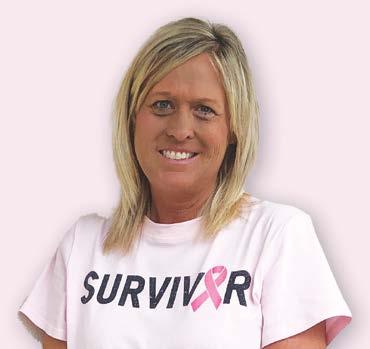




she had to wait a few days to receive the results. Her doctor’s o ce told her to keep watching the online patient portal to see if she had received anything.
“Two days later I was sitting in the Memphis airport, and I was watching the portal. About 10 minutes before I boarded the plane, I got a long message from the doctor’s o ce. I didn’t really understand what it meant, so I contacted a friend to help me decipher.”
She eld said she got the news she was dreading. “As I was walking to board my flight, she told me it was DCIS, or ductal carcinoma in Situ. I was sitting there in my seat on the plane and just cried.”
She called Chris when she got to the conference in Charlotte. He told her that he would drive up there and pick her up, but She eld wanted to stay because she wanted to get the information needed for her job. She said her boss and the underwriter she works with both encouraged her to head home, but she felt like she should stay.
Gradually, she said, it “felt like the walls were closing in,” so she decided to leave a day early.
When she returned from Charlotte, She eld met with Dr. Sanders, and that is where she was o cially told she had cancer. At her next appointment, they discussed treatment options between a lumpectomy (since the malignancy was found only in the left breast) or a mascetomy. She eld said she was set on having a double mastectomy because she did not want to wonder if it would ever move to the other breast.
It was time to tell her children. “Mollie had just started her senior year. I watched the tears flow, thinking she was not ready to accept
it, but she said ‘Mama, you are not going to fight this alone. We are going to fight with you,’” Amanda said.
As she prayed later with Eli, he asked, “Mama, will you promise me one thing?” She eld said she would move heaven and earth for him if she could. He asked, “Can you just lay here and always be here with me?”
In October 2023, She eld went in for surgery. She said she was scared but, “I knew God was on my side, and there was nothing he and I couldn’t handle.”
In the weeks and months following the surgery, She eld found a supportive team in her husband, children, and friends. “Chris stepped up. The kids told me they knew I did a lot of stu for them, and they helped out, even checking due dates and paying bills.”
Even through the hardest points in the journey, her family was fighting with her. “When I was lying in the bathroom floor crying from the pain, Chris would lie down beside me and remind me that we were going to get through this.”
Daughter Mollie changed She eld’s drain tubes, telling her “Mama, we’ve got this.”
Eli told her “My friends and I prayed for you on the playground today.”
She eld said she would never forget all the prayers, texts, meals, and other expressions of concerns she received, including a special couple of times around the baseball field.
“Eli’s team all had on pink shirts because it was Breast Cancer Awareness Month. After the game, which Eli’s team won, they

presented me with a championship ring because they said, “You’re gonna be a champion with this, just like these boys are champions.”
She eld said she considers herself blessed because she did not have to go through chemotherapy or radiation. She said she knows she is a lot better o than many other people who have the disease, and she is grateful. She said cancer has brought her closer to God, and she “doesn’t take a single day for granted.”
She o ers some advice she hopes others will heed. “Don’t put o getting your mammograms, especially if it’s hereditary in your family or if you find something that just doesn’t feel right.”






We are going to fight with you.

Let these cozy soup recipes get you into the “Autumn spirit” and enjoy comfort food with friends and family. Add a avorful salad and a warm loaf of bread, and you have a tasty meal sure to please!
George (PEPA Retiree) and Martha Stegall
INGREDIENTS
1 pound ground beef
2 cans corn
2 cans hominy
2 cans kidney beans
2 packages onion soup mix
Brown beef in large Dutch oven. Drain fat. Add remaining ingredients and simmer two to six hours.
Note: Best cooked in cast iron.
Mary Williamson, PEPA Collections Manager
2 tablespoon butter or margarine
1 medium carrot, coarsely shredded
1 small green pepper, chopped
½ teaspoon salt
¼ teaspoon dried thyme leaves
1 10 ½ ounce can condensed chicken broth
1 ½ cups canned or frozen cooked wild rice
½ cup slivered almonds, toasted
2 medium stalks celery, sliced
1 medium onion, chopped
¼ cup Bisquick
¼ teaspoon pepper
1 cup water
1 cup half and half ¼ cup chopped fresh parsley
In 3-quart saucepan, melt butter over medium-high heat. Add celery, carrot, onion, and bell pepper. Cook about 4 minutes, stirring occasionally, until tender. Stir in Bisquick, salt, pepper, and thyme. Stir in water, broth, and wild rice. Heat to boiling, stirring frequently. Reduce heat to low, cover and simmer 15 minutes, stirring occasionally. Stir in half and half, almonds, and parsley. Heat until just hot. Do not boil. Makes 4 servings.
Teaching students about electrical safety is important to us. Recently, we were asked to visit North Pontotoc Elementary kindergartners for their Community Helper Day. We were also asked to take part in Pontotoc Elementary School’s Touch a Truck event for their kindergartners. The students enjoyed getting their own hard hat and learning about the jobs our crews perform every day.







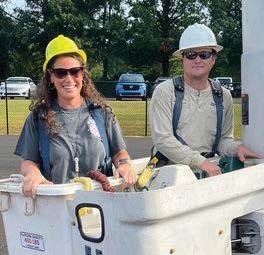
























October is National Cooperative Month, an opportunity to celebrate how cooperatives operate to benefit their members and communities. Many communities rely on cooperatives to provide locally grown food, housing, electricity, financial services, internet, retail services, and so much more. Singing River Electric joins more than 800 electric cooperatives in recognizing Cooperative Month and reflecting on why and by whom we were formed. Since 1938, Singing River Electric has been operated by and for the people of the communities we serve. In addition to our steadfast mission to provide safe, reliable, and a ordable electricity, we continuously seek ways to live out the seven cooperative principles. One of those principles is “concern for community.” Taking care of the communities we serve continues to be a priority for Singing River Electric board members and employees. Singing River Electric puts a strong emphasis on community support through programs that provide


education, assistance, and value to members. When our employees volunteer in the community, they get to focus on what really matters – the people. Our Neighbors Helping Neighbors Community Grant Program, community cleanup events, and youth education programs are just a few ways we add value to the place we call home.
The decision to build and maintain a fiber network is another way we’ve shown our dedication to the communities we serve. Not only do these fiber lines allow us to monitor our substations in real time and shorten outage response times, but they also provide our members with high-speed internet. We are seeing the excitement of those in the communities we serve as this fiber internet movement has added value to our subscribers’ lives.
As a member-owned electric cooperative, Singing River Electric will continue to act in ways that support and strengthen our local communities.


by Brian Hughey
General Manager and CEO









AMANDA PARKER, CCC Manager of PR and Marketing



















This October, let a fun Halloween theme inspire your energy-e ciency e orts.
• Conjure savings with smart thermostats. Home heating and cooling account for a large portion of monthly energy use, so one of the easiest ways to save energy is through thermostat control. Smart thermostats can help you manage heating/cooling costs by learning your daily routine and adjusting the temperature settings accordingly.
• Are energy vampires lurking in your home? These are devices that consume electricity even when you're not using them. Unplug chargers, turn o lights, and use smart power strips to vanquish energy vampires.
• Get rid of goosebumps by eliminating ghostly drafts! The winter chill is just around the corner, so now is the time to seal air leaks around your home. Apply caulk and weatherstripping around drafty windows and doors to make your home more comfortable (and lower energy use).
• Illuminate your lair with energy e cient lighting. LED bulbs use 75% less energy and last 25 times longer than incandescent light bulbs.



Hurricane Francine made landfall in Louisiana’s Terrebonne Parish as a Category 2 storm on September 11, 2024. Singing River Electric’s service area began experiencing gusty winds and heavy rain that evening as a result. Our linemen responded to outages until tropical storm-force winds prevented them from continuing. Power restoration began again before daylight on September 12 with all power being restored by early afternoon.
Outages were primarily caused by wind blowing trees and limbs onto the power lines. There were fortunately few broken poles.
During the two-day storm, Singing River Electric had 178 outages with 5,306 member meters a ected.

Thank you to all Singing River Electric members for your patience and support during storm restoration. Special thanks to our employees who handled dispatch, engineering and operations, public relations, meals, equipment, and other behind-the-scenes roles that aid the power restoration process.







Singing River Electric clears trees, limbs and underbrush from the area around and below the power lines called the right of way. Right-of-way clearing helps decrease the number of outages and reduces the risk of someone coming in contact with power lines.
Here are the substations and surrounding areas that are either currently being cleared or where clearing will begin soon:
• Gautier substation – Graveline Road, Highway 90, Old Spanish Trail, and surrounding areas.
• Gulf Park substation – Beachview Drive, Spring Avenue, Riley Road, and surrounding areas.
• Leakesville substation – Highway 57, Highway 63, Old Avera Road, and surrounding areas.
• Sand Hill substation – Highway 42, Highway 63, Turkey Fork Road, and surrounding areas.




Singing River Connect recently installed fiber internet service to our 10,000th subscriber!




To celebrate this milestone, we recognized George County’s Nicole Harvey as our 10,000th subscriber and presented her with a smart home kit.
Nicole raves about her service, saying: “Singing River Connect has been wonderful in our home! Uploads for my business are much faster, and my daughter’s gaming experience is seamless without bu ering. Our work-fromhome time has never been better!”






Thank you to all our subscribers for helping us reach this milestone and for allowing Singing River Connect to be your trusted local provider. We are excited to continue bringing fast, reliable fiber internet to Singing River Electric members.


The 2024 dove hunting season began September 1, and Singing River Connect has already experienced multiple internet outages because fiber lines were shot.
Shooting doves o fiber lines or power lines can interrupt service and damage expensive equipment. Do not shoot at or near electrical equipment, fiber lines, power lines, or substations.
Any fiber internet lines damaged due to gunshots will be repaired at the expense of the landowner.









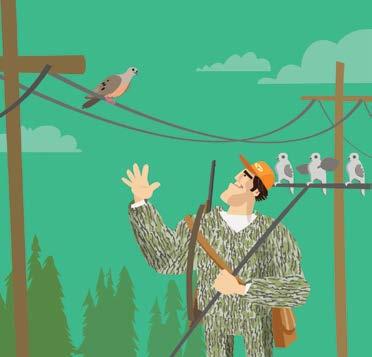



Step 1: Make-ready engineering Examine. Design.
Monaco Lake and Kreole substation areas


Step 2: Make-ready construction




Step 4: Splicing
Connecting the dots.



Planning the most efficient approach to fiber deployment.
Fountainbleu, Singing River Mall, Gautier, and Hamill Farm substation areas


Step 3: Fiber Construction
Building a network from the ground up.


Sunplex, Ocean Springs, Gulf Park, Fort Bayou, Martin Bluff, Hickory Hills, St. Martin, Tucker Road, and Forts Lake substation areas




Wade, Helena, Helena Industrial, and Escatawpa South substation areas


Step 5: Service drop & drop splicing
The last outdoor step. Almost there…
Benndale, Rocky Creek, Leakesville, Lucedale North, Vancleave, Joe Batt, and all previously opened areas




Step 6: Installation
The speed of light, right to your home.



Rocky Creek, Leakesville, Lucedale North, Vancleave, Joe Batt, and all previously opened areas







Leakesville Elementary and Sand Hill Attendance Center recently received 5’x 8’ embroidered Mississippi state flags. Mississippi's flag design, approved by voters in 2020, includes a white magnolia blossom encircled with 20 white stars, one gold star, and the words “In God We Trust.” Other schools in the district will receive flags in the coming months.
Singing River Electric employees enjoyed a special treat when presenting the state flag to Leakesville Elementary – the first-grade class recited the pledge of allegiance to the Mississippi flag.


I salute the flag of Mississippi and the sovereign state for which it stands with pride in her history and achievements and with confidence in her future under the guidance of Almighty God.


Neighbors Helping Neighbors Community Grant funds benefit two child-focused projects in our local community.
Resurrection Catholic Elementary in Pascagoula created a music program to help students develop their musical talents, learn about musical genres, and participate in performances. A $2,500 NHN Grant purchased castanets, frame drums, floor tom drums, toddler drums, rhythm sticks, rain sticks, egg shakers, maracas, and a tambourine.


A $2,500 NHN Grant purchased a play structure with swings and a slide as well as foundation surfacing for the Salvation Army’s Center of Hope in Jackson County. The playground equipment is an extension of the Character Education Program, which is aimed at youth of all ages to build on positive social and communication habits, decision-making and life skills, and spiritual and physical wellness.
For more information on SRE NHN Community Grants and how to apply, visit singingriver.com/my-community. Grants for up to $2,500 are awarded to nonprofits in SRE’s service area three times a year in January, May, and September.






At Southern Pine Electric, our strength comes from you, our valued members. As we approach our annual directors’ election, I want to emphasize the importance of your participation. The decisions we make as a cooperative are guided by those who we choose to represent us. Your vote is your voice in ensuring that Southern Pine Electric continues to operate in the best interests of our members.
This year, we’re also reminded of the broader importance of voting as we look toward the state and national elections. Just as your vote shapes the future of Southern Pine, it also plays a crucial role in shaping the future of the United States. Your vote is not just a mark on a ballot; it’s a powerful tool that can influence the direction of our cooperative and our country. Every vote matters, whether for the leaders of our cooperative, our state, or our country.
When you receive your ballot for our directors’ election, I encourage you to review the board members who are up for re-election and cast



your vote. Your participation is not just important; it’s vital. It’s what keeps our cooperative strong, responsive, and focused on what matters most to you. Your vote is a crucial part of our decisionmaking process, and we value your input.
Thank you for being an active and engaged member of Southern Pine Electric. Together, we can ensure that Southern Pine and our country continue to thrive.

by Chris K. Rhodes
President/CEO Southern Pine Electric























In March 1993, the New Hebron District o ce opened its doors to help Southern Pine Electric develop closer relationships with members and provide e cient and e ective service. Serving Copiah, Je Davis, Lawrence, Simpson, and portions of Covington and Lincoln counties, the district delivers electric service to approximately 15,447 meters.
Long before opening the district o ce, Southern Pine has always been a part of the communities we serve. Whether it is a member services representative assisting members or a lineman ensuring your power lines are up and running, we are here for you. Each member of the New Hebron team is vital to the communities we serve.
New Hebron is a challenging geographical area with complicated weather patterns. Many storms follow a path across the Mississippi River and into Copiah County. This weather pattern and unusually wooded terrain can cause significant issues when storms occur. Our team is always ready when our members need us, so we will be there when trouble strikes.
One of the biggest blessings of working in the communities we serve is building relationships with our members. Our team loves to stay connected to our members because we live here and are part of the communities we serve. Working together, we strive to bring our members the best service possible while bringing the power.


out. “I’ll never forget proudly
Brandon Henderson has led the New Hebron team for three years and served the members of Southern Pine for over 25 years. Prior to becoming district manager, Brandon was a staking technician. He has so many memories of his work over the years, but one stands out. “I’ll never forget proudly leading a mile-long convoy of bucket trucks during the Hurricane Katrina power restoration e ort,” Brandon said. “It was amazing how everyone worked together for days on end to restore power to all members
after Katrina,” Brandon said. He said he enjoys working alongside Southern Pine’s highly skilled and dedicated employees.
Brandon and wife, Betsy, have been married for one year. He’s the proud father of two sons, Trustin and Braydon, and a daughter, Emma. Brandon and Betsy live in New Hebron where they enjoy spending time with their family. In his spare time, he loves to shoot guns.
It was amazing how everyone worked together for days on end to restore power to all members after Katrina.


Kaci Johnson has served the New Hebron district’s members as o ce supervisor for the last four years. Before that, she was a member service representative for four years. Kaci loves Southern Pine and enjoys the family atmosphere and visiting with all the members. “A lot of great friendships have been made over the years,” said Kaci.
“Some of my favorite memories are participating in our town Halloween trick-or-treat activities. Our district ladies dressed up, decorated a bucket truck, and passed out candy to our members and the community. It was so much fun!”
Kaci lives in Magee and loves spending time with her family. She and her husband, Justin, have been married for nine years and have two boys, Tripp and Tucker. When she is not serving the members, Kaci loves to compete in rodeos.
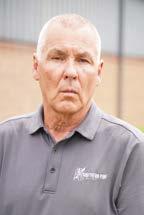

Celebrating 44 years of service is a significant achievement, and Randy Nichols is still taking on new challenges. He accepted the role of field supervisor just seven months ago and has done a great job of leading his men in the field. Before accepting the role, Randy worked as a lineman, working foreman, and a construction supervisor.
One of Randy’s favorite memories of his time at Southern Pine is working with his dad, Bill Everett. Randy said that working with his fellow employees is what he enjoys most about being at Southern Pine. Randy and his wife, Miranda, have been married for eight years and have three children and three grandchildren. They live in New Hebron, where they enjoy spending time with family. When he’s not working, Randy likes to deer and turkey hunt.


New Hebron’s newest journeyman lineman, Cooper Holyfield, earned that title five months ago. Cooper served our members for over five years as an apprentice lineman before earning his new title.
Cooper said the most enjoyable and rewarding part of working with Southern Pine is the satisfaction of restoring power and ensuring reliable service for the community. “One of my favorite things we get to do from time to time is talk to the kids at touch-a-truck events. Seeing the kids’ faces when we show them what we do as linemen is great,” said Cooper. Cooper lives in Mendenhall and loves all things outdoors and cooking.
with his fellow employees is what he enjoys
33
One of my favorite things we get to do from time to time is talk to the kids at touch-a-truck events.
EMPLOYEES
471 Years of combined service
15,447 Meters
Miles of line Over 2
2,677 54,771 POLES
14,034 TRANSFORMERS LINE CREWS 4 SERVICEMEN Counties
7

























THURSDAY, NOV. 14, 2024

THE JORDAN BUILDING 13491 HWY 28 l TAYLORSVILLE, MS






DOORS OPEN: 10 A.M.
BUSINESS MEETING: 11 A.M.
We hope you’ll join us for Southern Pine’s 2024 Membership Meeting. The event will feature a Lowe’s winterization booth with tips and ideas to help lower bills, information about the new Members Helping Members program, and Member Spotlight booths. Brunch will be provided and expect door prizes galore!



M. BERRY


Billy Berry has served the members of Southern Pine as the director of Simpson county and currently serves as Chairman of the Board. Berry has served on the Cooperative Energy board and as a supervisor for Simpson county, Mississippi. He previously served on advisory boards for Deposit Guaranty Bank and the Monticello and New Hebron branches of AmSouth Bank. Berry and his wife, Debbie, have four children, eight grandchildren, and one great-grandchild.


Je ery Sims has served the members of Southern Pine as director of Forrest county. Owner of a timberland development business, Sims promotes farming techniques to advocate for the timber industry throughout Mississippi. Sims is a chief process engineer for refineries and performs business evaluations. He currently serves as a board member for Wesley Manor. Sims and his wife, Angelia, are very active in their community.


David Tadlock has served the members of Southern Pine as the director of Scott county. Owner of a cattle business, Tadlock promotes industry standards and rural economic development. Active in numerous community and regional associations, he is dedicated to improving the lives of Mississippians. He and his wife, Sandy, have two children.


Haskins Montgomery has served the members of Southern Pine as the director of Jasper county. Serving as president of the Board of Trustees for Jasper General Hospital and for the MidMississippi Development District, he also serves as a member of the Mississippi Economic Development Council. Retired from government service, Montgomery served as a mayor, alderman, and as a state senator for eight years. Montgomery and his wife, Diana, have three children and six grandchildren.









































by Abby Berry
Communities come in all shapes and sizes. Some are based on geographical proximity; some are based on shared interests or hobbies, and some communities can even be found in virtual spaces like social media groups. Regardless of where or how they are formed, communities can bring people together and create a sense of belonging.
Southwest Electric is deeply committed to our Members, and we’re glad you are part of the electric cooperative community.
This month, more than 30,000 cooperatives across the U.S. are celebrating National Cooperative Month. It’s a time to reflect on all the aspects that set cooperatives apart from other types of businesses, but more importantly, it’s a time to celebrate the power of cooperative membership.
Electric cooperatives are not-for-profit utilities that are built by the communities they serve. For Southwest Electric, our mission has always been to provide you with reliable power. We care about your quality of life, and because we are locally operated, we’re uniquely suited to meet our Members’ evolving energy needs.
Beyond the business of electricity, our employees and directors are equally invested in our local community. Why? Because we live here, too. That’s why we work hard to support local economic development projects, youth programs, charitable giving initiatives and additional programs that make our community a better place to call home.
All cooperatives, including Southwest Electric, are guided by seven cooperative principles that embody the values and spirit of the cooperative movement.








These seven principles are a framework to help all cooperatives navigate challenges and opportunities while remaining true to our purpose:
1. Open and Voluntary Membership: Cooperative membership is open to anyone who can use the cooperative’s services.
2. Democratic Member Control: Members make decisions that shape the cooperative. Why? Because cooperatives are created by the Members, for the Members.
3. Members’ Economic Participation: Members contribute money to the cooperative to make sure it runs smoothly now and in the future. At Southwest Electric, this happens through paying your energy bills.
4. Autonomy and Independence: Cooperatives are independent and can operate on their own, which ultimately benefits the Members.
5. Education, Training, and Information: Cooperatives continuously focus on education to ensure employees have the training and information they need to make the cooperative successful.
6. Cooperation Among Cooperatives: Cooperatives share with and learn from other cooperatives. We help each other out in times of need because we want other cooperatives to thrive.
7. Concern for Community: All cooperatives work for the greater good of the local communities they serve. Cooperatives give back to their communities to help them thrive and grow.
Always remember to “LOOK UP” when working around power lines.
Tall loads can come into contact with energized lines and even break several poles. You could be held responsible for the damage caused.





























































































by Steven Ward
Southwest Electric Member Matt Mangold had a dream and a goal for his autistic, non-verbal son.
He wanted him to experience shooting a deer.
When his son, Logan, was a youngster, Mangold took him to participate in the annual Southern Outdoors Unlimited Super Hunt. The hunt was created for children with disabilities and special needs.
The problem was Logan aged out of the Super Hunt at 17.
Mangold thought there needed to be a program for youth 17 and older. In fact, Mangold wanted to make sure special needs children of all ages had an opportunity to experience the outdoors, like any other child.
To that end, Mangold and his wife, Lauren, co-founded the non-profit, faith-based organization, C.A.M.O. Ministries in 2020. The mission of C.A.M.O Ministries (Christian Ambassadors Ministering Outdoors) is to provide outdoor opportunities to disabled and special needs individuals by providing a supportive, family-friendly environment.
Mangold said C.A.M.O. provided deer hunting opportunities to about 30 people last year.
“I told some of our guides and volunteers that once you see the face of a child who shoots a deer, you won’t care if you ever shoot a deer again. It just means everything to them,” Mangold said.
Mangold said C.A.M.O has hosted a 14-year-old blind girl from Crystal Springs for the last couple of years. She shot two deer.
“We have this amazing tripod camera system. And of course, the guide aims the gun, but she got to pull the trigger. She got so excited. She was out there after rubbing the deer. It was an incredible reaction,” Mangold said.
Besides deer hunts, C.A.M.O Ministries also hosts fishing trips and turkey hunts.
C.A.M.O. averages about 90 outdoor enthusiasts a year with hunts and fishing trips all over the state.






Mangold said some of the hunts take place at his family hunting club, Zeke’s Hunting Club in Dentville, a community in Copiah County. The club is served by Southwest Electric.
The deer blinds involved are accessible by wheelchairs. However, Mangold said he’s hoping he can raise enough money to buy track chairs — action chairs that can be utilized by the wheelchair-bound — for his physically disabled hunters.
C.A.M.O. also holds special hunts for veterans. Those events are known as Wounded Warrior hunts.
“We’ve had veterans in their 60s and 70s participate. So, the age range is just about everyone at any age,” Mangold said.
Mangold said C.A.M.O. also partners with the Southern Outdoors Unlimited Super Hunts. In addition, C.A.M.O partners with Hope Outdoors Hickory Ridge Baptist Church in Florence and the Copiah County Baptist Association to secure locations and land for their hunts.
During hunts, there are always two adults with each hunter — a guide and a volunteer. Sometimes that volunteer is a parent; sometimes it’s not.
“Sometimes mom and dad just need a break. And we get that. But we always make sure there are two people with the hunters during the activity,” Mangold said.
C.A.M.O. Ministries is always looking for volunteers, sponsors and donations.
For more information about how to volunteer or donate, email laurenm@camoministries.com, visit camoministries.com or call 601-955-5933.



























twincoepa.com




@twincoepa
Hollandale - 662-827-2262 | Belzoni - 662-247-1909 | Greenville - 662-334-9543 | Rolling Fork - 662-873-4233 | REPORT OUTAGES 866-897-7250





by Abby Berry
Communities come in all shapes and sizes. Some are based on geographical proximity; some are based on shared interests or hobbies, and some communities can even be found in virtual spaces like social media groups. Regardless of where or how they are formed, communities can bring people together and create a sense of belonging.
Twin County Electric is deeply committed to our consumermembers, and we’re glad you are part of the electric cooperative community.
This month, more than 30,000 cooperatives across the U.S. are celebrating National Co-op Month. It’s a time to reflect on all the aspects that set cooperatives apart from other types of businesses, but more importantly, it’s a time to celebrate the power of co-op membership.
Electric cooperatives are not-for-profit utilities that are built by the communities they serve. For Twin County Electric, our mission has always been to provide you with reliable power. We care about your quality of life, and because we are locally operated, we’re uniquely suited to meet our members’ evolving energy needs.
Beyond the business of electricity, our employees and directors are equally invested in our local community. Why? Because we live here, too. That’s why we work hard to support local economic development projects, youth programs and scholarships, charitable giving initiatives and additional programs that make our community a better place to call home.
All co-ops, including Twin County Electric, are guided by seven cooperative principles that embody the values and spirit of the cooperative movement.
These seven principles are a framework to help all co-ops navigate challenges and opportunities while remaining true to our purpose:
1. Open and Voluntary Membership: Co-op membership is open to anyone who can use the co-op’s services.
2. Democratic Member Control: Members make decisions that shape the cooperative. Why? Because co-ops are created by the members, for the members.
3. Members’ Economic Participation: Members contribute money to the co-op to make sure it runs smoothly now and in the future. At Twin County Electric, this happens through paying your energy bills.
4. Autonomy and Independence: Co-ops are independent and can operate on their own, which ultimately benefits the members.
5. Education, Training, and Information: Co-ops continuously focus on education to ensure employees have the training and information they need to make the co-op successful.
6. Cooperation Among Cooperatives: Co-ops share with and learn from other cooperatives. We help each other out in times of need because we want other co-ops to thrive.
7. Concern for Community: All cooperatives work for the greater good of the local communities they serve. Co-ops give back to their communities to help them thrive and grow.
This October, as we celebrate National Co-op Month and the power of membership, we hope you will recognize the many aspects that set electric cooperatives apart. Our mission is reliable power. Our purpose is people — the local communities we’re proud to serve. Abby Berry writes on consumer and cooperative a airs for the National Rural Electric Cooperative Association.


















QDo you have any tips on finding hidden energy savings in my home?
by Miranda Boutelle
Using your attic for storage can be problematic when trying to maximize your home’s energy e ciency. Let’s explore how you can improve insulation levels and properly store items in your attic.
Attic insulation is one of the best low-cost ways to make your home e cient. People often associate insulation with keeping your home warmer in the winter, but it also provides benefits in the summer. Insulation reduces heat transfer from the attic to the house, which lowers energy bills for air conditioning and makes your home more comfortable.
AI’ve been in a lot of homes. One common hiding spot for energy savings is the attic. It is also a common location for storing holiday decorations and infrequently used sentimental items.
Attic insulation is measured in R-value, which is a measurement of how well a material resists the flow of heat. For attic insulation, thicker is better. The recommended R-value is typically between R-38 and R-60, depending on your climate. Hawaii and the southernmost tips of Florida and Texas recommend R-30. Measured in inches, that ranges from around 10 to 20 inches, depending on the type of insulation you have. In most homes, the ceiling joists are buried in insulation to achieve the recommended R-value.
The problem with attic storage is it typically doesn’t o er enough space for the recommended R-value. Often, plywood or boards are placed directly on top of the ceiling joists, which isn’t enough space for the insulation. Insulation can get compacted by people moving items in or out, reducing the e ective R-value.
Ideally, the attic would not be used for storage so it can be properly insulated, but that’s not feasible for everyone. Here are some strategies for maintaining attic storage and recommended insulation levels.
The best location for attic storage is over an unconditioned area of your home, such as the garage. You don’t need insulation in attic spaces over a garage or unconditioned area because you are not heating or cooling the space below. This makes it the perfect spot to tuck away items for storage.
If that isn’t an option, consider minimizing the number of stored items or the storage area’s footprint. A great way to do this is by building an attic storage platform. A raised platform allows the space underneath it to be fully insulated. These platforms are available in ready-to-install kits, or you can buy materials and build them yourself.

Your attic might also have trusses that allow you to build shelves and maximize space by storing items vertically.
Allow enough space underneath the platform to achieve the proper R-value. Use lumber to build a frame perpendicular to the existing joists and cover it with plywood or oriented strand board. Once your storage area is set up, add insulation inside the platform to bring the R-value up to the proper level.
Your attic might also have trusses that allow you to build shelves and maximize space by storing items vertically.
Always wear a dust mask or respirator when working in the attic. Don’t forget to weatherstrip the attic hatch to ensure a tight seal. Take a look around your attic to see if you can find any hidden opportunities for energy savings.
Miranda Boutelle is the chief operating o cer at E ciency Services Group in Oregon, a cooperatively owned energy e ciency company.





















by Abby Berry
Did you know the average household with internet access owns about 17 connected devices? That figure covers a wide range of electronics, including smart phones, computers, streaming devices, smart speakers, home assistants, and more. Given our increasing reliance on internet-connected technologies, the likelihood of new cyber threats is ever-present.
Twin County Electric is deeply committed to ensuring our local system is safe and secure. We routinely monitor and manage cyber risks, and we work together with other co-ops to share the latest advancements in cybersecurity measures that make us stronger. But you can help, too.






When we all work together to stay safe online, we lower the risk of cyber threats to our systems, online accounts, and sensitive data.
October is National Cybersecurity Month, and while good cyber hygiene should be practiced year-round, we’d like to share a few cybersecurity tips to help you bolster your online safety.
Let’s all do our part to stay cyber smart and create a safer digital world for all. Visit staysafeonline.org to learn about additional cybersecurity tips.
Abby Berry writes on consumer and cooperative a airs for the National Rural Electric Cooperative Association.

Learn how to spot and report phishing attempts. Phishing occurs when criminals use phony emails, direct messages or other types of digital communications that lure you to click a bad link or download a malicious attachment. If you receive a suspicious email or message that includes urgent language, o ers that seem too good to be true, generic greetings, poor grammar, or an unusual sender address, it could be a phishing attempt. If you spot one, report it as soon as possible — and don’t forget to block the sender. (If you receive a suspicious work email, report it to the appropriate IT contact. Suspicious messages that are delivered to your personal email or social media accounts can also be reported.)
Create strong, unique passwords. When it comes to passwords, remember that length trumps complexity. Strong passwords contain at least 12 characters and include a mix of letters, numbers, and symbols. Create unique passwords for each online account you manage and use phrases you can easily remember.
Enable multi-factor authentication when available. Multi-factor authentication (also known as 2-factor authentication) adds an extra layer of security to your online accounts. These extra security steps can include facial recognition, fingerprint access, or one-time codes sent to your email or phone.
Update software regularly. Software and internet-connected devices, including personal computers, smartphones, and tablets, should always be current on updates to reduce the risk of infection from ransomware and malware. When possible, configure devices to automatically update or notify you when an update is available.


































by Abby Berry
Communities come in all shapes and sizes. Some are based on geographical proximity; some are based on shared interests or hobbies, and some communities can even be found in virtual spaces like social media groups. Regardless of where or how they are formed, communities can bring people together and create a sense of belonging.
Yazoo Valley Electric is deeply committed to our consumermembers, and we’re glad you are part of the electric cooperative community.
This month, more than 30,000 cooperatives across the U.S. are celebrating National Co-op Month. It’s a time to reflect on all the aspects that set cooperatives apart from other types of businesses, but more importantly, it’s a time to celebrate the power of co-op membership.
Electric cooperatives are not-for-profit utilities that are built by the communities they serve. For Yazoo Valley Electric, our mission has always been to provide you with reliable power. We care about your quality of life, and because we are locally operated, we’re uniquely suited to meet our members’ evolving energy needs.
Beyond the business of electricity, our employees and directors are equally invested in our local community. Why? Because we live here, too. That’s why we work hard to support local economic development projects, youth programs and scholarships, charitable giving initiatives and additional programs that make our community a better place to call home.
All co-ops, including Yazoo Valley Electric, are guided by seven cooperative principles that embody the values and spirit of the cooperative movement.
These seven principles are a framework to help all co-ops navigate challenges and opportunities while remaining true to our purpose:
1. Open and Voluntary Membership: Co-op membership is open to anyone who can use the co-op’s services.
2. Democratic Member Control: Members make decisions that shape the cooperative. Why? Because co-ops are created by the members, for the members.
3. Members’ Economic Participation: Members contribute money to the co-op to make sure it runs smoothly now and in the future. At Yazoo Valley Electric, this happens through paying your energy bills.
4. Autonomy and Independence: Co-ops are independent and can operate on their own, which ultimately benefits the members.
5. Education, Training, and Information: Co-ops continuously focus on education to ensure employees have the training and information they need to make the co-op successful.
6. Cooperation Among Cooperatives: Co-ops share with and learn from other cooperatives. We help each other out in times of need because we want other co-ops to thrive.
7. Concern for Community: All cooperatives work for the greater good of the local communities they serve. Co-ops give back to their communities to help them thrive and grow.
This October, as we celebrate National Co-op Month and the power of membership, we hope you will recognize the many aspects that set electric cooperatives apart. Our mission is reliable power. Our purpose is people — the local communities we’re proud to serve.







by Jason Patterson
In February of 1927 a group of citizens from all over Yazoo County gathered at the courthouse to form the Yazoo County Fair Association.
The group raised $10,000, and when the first Yazoo County Fair was held in 1928 it was a source of pride for the local community.
“With such enthusiastic support from every section of Yazoo County, the movement can hardly fail, and it is our prediction that Yazoo County will have one of the best fairs in the state this fall,” The Yazoo Herald wrote after the first meeting.
The newspaper’s prediction would come to pass, and the first fair held in 1928 was truly something special. Nearly a century later the Yazoo County Fair remains the county’s largest attraction.
“This fair was founded as a way to showcase the talent of our residents and to provide clean family fun,” said Martin McGraw, chairman of the Yazoo County Fair Association. “That remains the mission today.”
For McGraw the fair is a family tradition. His father, the late Hugh McGraw, first served on the fair’s board of directors in the 1940s before he was elected as a Yazoo City alderman. Hugh McGraw was serving as commander of the Roy Lammons American Legion Post No. 7 when he was asked to consider serving on the fair board again in 1965.
“The gentlemen who were on the fair board then were getting older and looking for some younger people to pick it up,” McGraw said.




“My dad was asked if he would like to do it, and the saw it as an opportunity to be a fundraiser for the American Legion.”
McGraw became the chairman of the fair board that year, and he continued to serve in that position until his death in 2008. Martin McGraw was elected chairman in 2010 and continues to serve in that position.
“Our family has been associated with it for so long that some people call it the McGraw Fair,” he said. “That kind of bothers me because this is not the McGraw fair; it is very much a community fair. There are a lot more people than just the McGraws making this happen.”
The fair has continued to grow over the years. Around 2010 the fair was averaging between 10,000 to 15,000 visitors each year. It broke 20,000 for the first time, and other than in 2020 when Covid
forced the fair to limit its activities, attendance has been breaking records each year. The fair has also drawn more visitors from other counties in recent years as word has spread.
McGraw said there are several reasons he believes the fair has been successful.
One is that it offers excellent value. Parking is free and the price of admission covers all the rides you want to ride. Many fairs require visitors to purchase tickets for each ride. The fair also has a long relationship with Miller Spectacular Shows, and the company always brings popular rides and food vendors.
Another is the family-friendly atmosphere. There is no alcohol served at the fair, and there is plenty of security to ensure a safe environment.
The rides, and of course the food, bring plenty of visitors to the fair. Another longtime favorite attraction includes the exhibits on display that include everything from artwork and photography to canning fruits and vegetables.
“A lot of people are starting to get back into canning and arts and crafts,” McGraw said. “I encourage anyone doing any of these things to enter their work in the exhibits at the fair.”
McGraw said the Mississippi State University Extension Service deserves much of the credit for the success of the exhibits.
This year’s fair will be held from Oct. 11-19 at the Yazoo County Fairgrounds located at 120 Hugh McGraw Drive in Yazoo City.
Check out the Yazoo County Fair page on Facebook for updated information on times and admission prices.
As he looks forward to the fair, McGraw said he can’t help but be excited even though he’s been involved with the fair his entire life.
“I still like to ride the rides, play the games, and eat the food,” McGraw said. “Seeing the faces of the kids when they pick up a duck and win a prize or when they get off of a ride grinning from ear to ear makes my day. I love seeing the joy on the faces of the families visiting our fair.”


The 2024 Yazoo County Fair will be held Oct. 11-19.
Follow the fair’s Facebook page for updates on times and ticket prices.









by Abby Berry
Did you know the average household with internet access owns about 17 connected devices? That figure covers a wide range of electronics, including smart phones, computers, streaming devices, smart speakers, home assistants, and more. Given our increasing reliance on internet-connected technologies, the likelihood of new cyber threats is ever-present.
Yazoo Valley Electric is deeply committed to ensuring our local system is safe and secure. We routinely monitor and manage cyber risks, and we work together with other co-ops to share the latest advancements in cybersecurity measures that make us stronger. But you can help, too.






When we all work together to stay safe online, we lower the risk of cyber threats to our systems, online accounts, and sensitive data.
October is National Cybersecurity Month, and while good cyber hygiene should be practiced year-round, we’d like to share a few cybersecurity tips to help you bolster your online safety.
Let’s all do our part to stay cyber smart and create a safer digital world for all. Visit staysafeonline.org to learn about additional cybersecurity tips.
Abby Berry writes on consumer and cooperative a airs for the National Rural Electric Cooperative Association.

Learn how to spot and report phishing attempts. Phishing occurs when criminals use phony emails, direct messages or other types of digital communications that lure you to click a bad link or download a malicious attachment. If you receive a suspicious email or message that includes urgent language, o ers that seem too good to be true, generic greetings, poor grammar, or an unusual sender address, it could be a phishing attempt. If you spot one, report it as soon as possible — and don’t forget to block the sender. (If you receive a suspicious work email, report it to the appropriate IT contact. Suspicious messages that are delivered to your personal email or social media accounts can also be reported.)
Create strong, unique passwords. When it comes to passwords, remember that length trumps complexity. Strong passwords contain at least 12 characters and include a mix of letters, numbers, and symbols. Create unique passwords for each online account you manage and use phrases you can easily remember.
Enable multi-factor authentication when available. Multi-factor authentication (also known as 2-factor authentication) adds an extra layer of security to your online accounts. These extra security steps can include facial recognition, fingerprint access, or one-time codes sent to your email or phone.
Update software regularly. Software and internet-connected devices, including personal computers, smartphones, and tablets, should always be current on updates to reduce the risk of infection from ransomware and malware. When possible, configure devices to automatically update or notify you when an update is available.
It makes a lot of sense that Cooperative Month and football season are both during the fall. Just like we cheer for our favorite college football team, we have a lot of reasons to cheer for our local electric cooperatives. Electric cooperatives in Mississippi are often humble and won’t cheer for themselves, even though they strongly impact local communities every day. So, as I cheer for my Southern Miss Golden Eagles, I’ll also cheer for our local electric cooperatives since October is Cooperative Month.
Hurricane Francine headed towards the Mississippi/Louisiana border on Sept. 12. Line crews and support personnel prepared for the hurricane across south and central Mississippi. Other cooperative personnel across the state prepared to go help those without power after the storm. I am happy to report that our electric cooperatives were able to restore their own outages, so visiting crews didn’t have to come to their aid. As always, our linemen were ready to answer the call if they were needed.
On Sept. 17, eight electric cooperatives set up booths and encouraged community college students to register to vote. The Co-ops Vote program is a nationwide,


non-partisan e ort to sign-up voters before the Tuesday, Nov. 5, general election.
I often think about Cooperation Among Cooperatives, which is one of our guiding principles. There are so many examples of co-ops working together in Mississippi. This magazine is one of them. Our joint advocacy e orts, both with U.S. Congressional leaders and state legislators, encourage lawmakers to support sensible energy policies that assure reliable and a ordable electric power. Another great example is the Cooperative Youth Leaders program, which instills leadership and an understanding of democracy in high school juniors. These are just a few examples; there are many more.
As I said early on, electric cooperatives provide a lot of reasons for us to cheer, so celebrate Cooperative Month.


by Michael
Callahan
Electric Cooperatives of Mississippi












Send us your beautiful photos of a Mississippi sunrise or sundown. The photos must be high-resolution JPG files of at least 1 MB in size. Please send the photo as an attachment to an email to news@ecm.coop.
Each entry must be accompanied by photographer or sender’s name, address, and co-op.
SUBMISSION DEADLINE: Nov. 29. Select photos will appear in the January 2025 issue.
